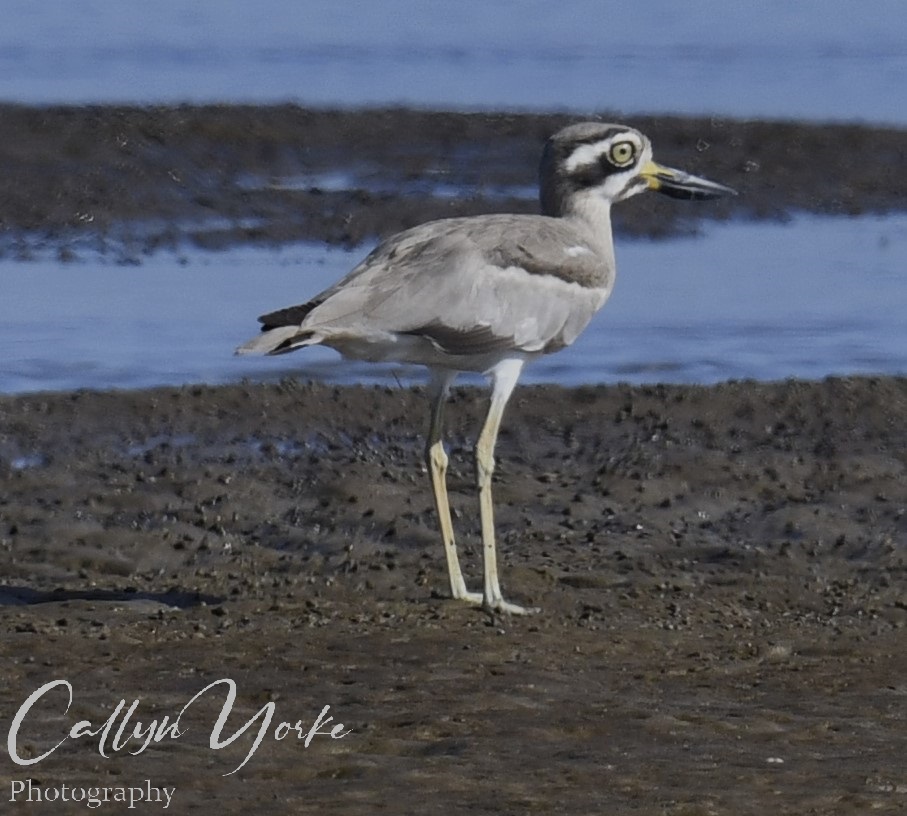
Việt Nam Coastal Bird Survey, September 13-23, 2023 Callyn Yorke
(Link to: Mekong Delta Bird Survey, January 2024)

Scroll down for Annotated Bird List
Introduction
The Palearctic – Australasian flyway presumably includes most of Việt Nam’s coastline, roughly 3,260 km, extending from Móng Cái in the north to Hà Tiên in the southwest. Along the coast, are many river mouths and adjacent wetlands that may offer food and shelter for migratory and resident birds. These coastal areas have probably been used by migratory birds for countless millennia.
However, the Việt Nam coastal region continues to experience massive impacts due to commercial developments and associated loss of wildlife habitat. There are almost no data available to resource agencies showing how these changes are affecting coastal migratory birds. Without baseline information, remedial conservation measures cannot be properly implemented.
From a global perspective, our knowledge of the status and distribution of waterbirds in Việt Nam is fragmentary and speculative. This is particularly true for birds relying upon coastal resources during Autumn and Spring migration (see Craik, Richard and Lê Quý Minh, 2018. Birds of Vietnam. Lynx Edicions. 400 pp.). This autumnal survey and summary report, aims to fill gaps in our knowledge of the coastal avifauna of Việt Nam and perhaps stimulate further fieldwork in the region.
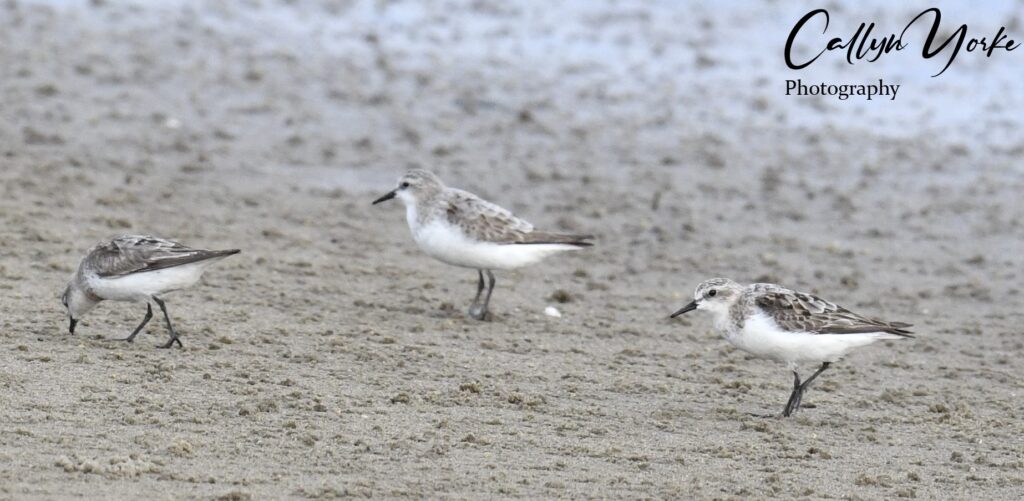
Lê Quý Minh and I began the coastal survey in the late afternoon of September 13, 2023, at Cửa Đại adjacent to Hội An. The tide was low, exposing sand and mudflats on the north bank of the river. As expected, a few locals and their dogs were in attendance, wading in the shallows and occasionally flushing flocks of shorebirds that we were attempting to identify and count. This would be a familiar scene at most of the coastal survey sites we visited over the next ten days.
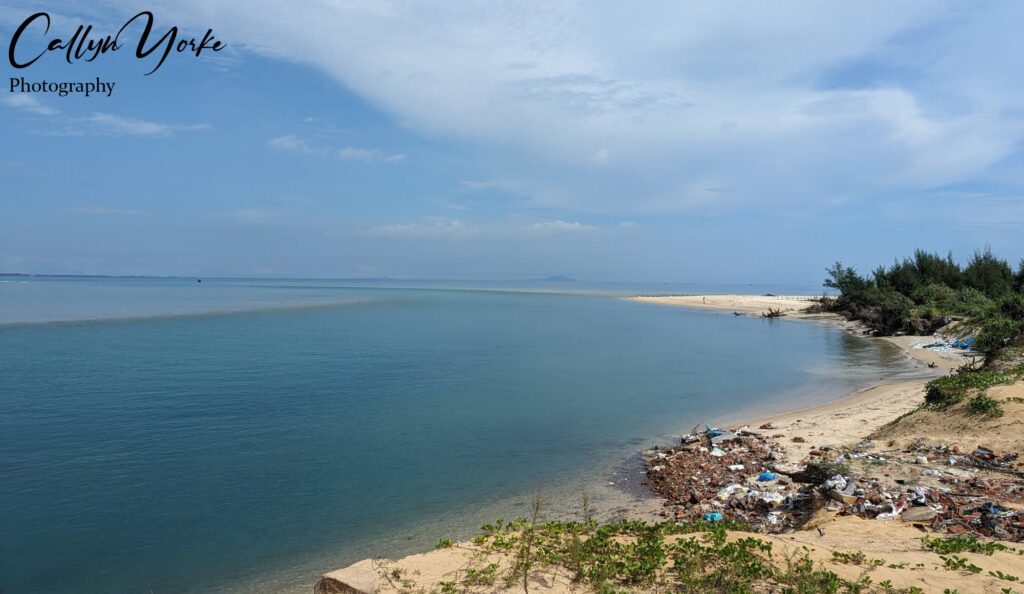
Coastal Việt Nam is densely populated and most of it has been variously modified or targeted for development. A profuse array of ingenious tidal fish traps, alongside aquaculture farms (i.e., shrimp and fish) are ubiquitous features. Everywhere, deltaic wetlands have been disturbed and reconfigured; mangroves cut and replaced by wood-chip plantations (e.g., Acacia mangium), waterways dredged, riverbanks reinforced with concrete and rocks, harbors congested with idle fishing boats.
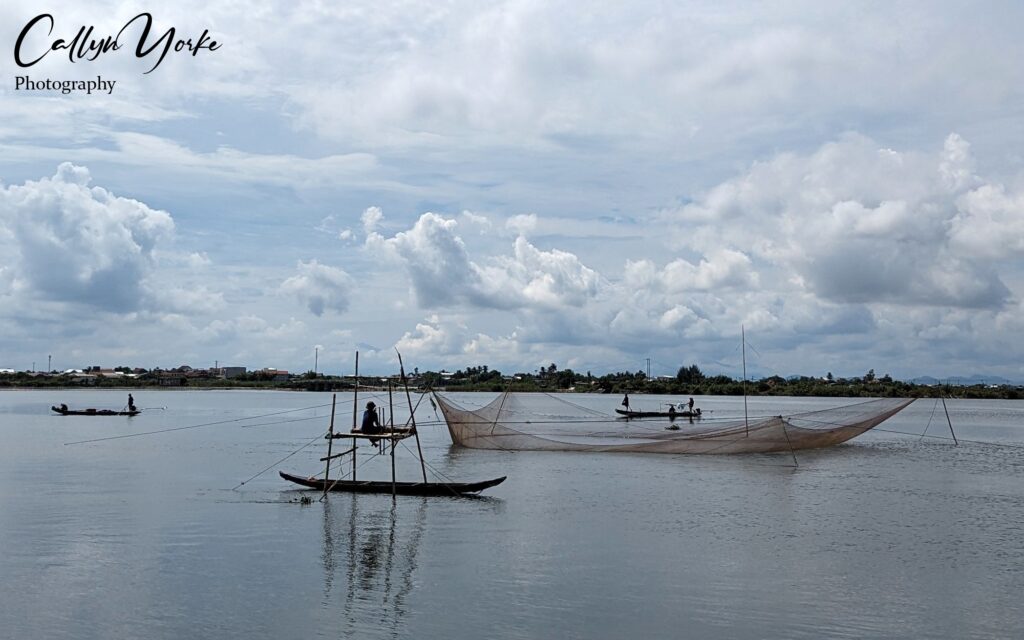
Adding an apocalyptic touch to these habitat alterations, estuaries and shorelines feature appalling accumulations of discarded plastic bottles, polystyrene containers, construction debris and various environmentally hazardous materials. Numerous luxury resorts and hotels are being planned or under construction (many projects were temporarily abandoned during the COVID pandemic, followed by a national crackdown on systemic corruption). Meanwhile, beaches, mangroves and mudflats are used daily by locals harvesting shellfish and nearly everything else edible, including birds. And so on. In short, finding suitable coastal habitat in Việt Nam is challenging both for birds and birders.
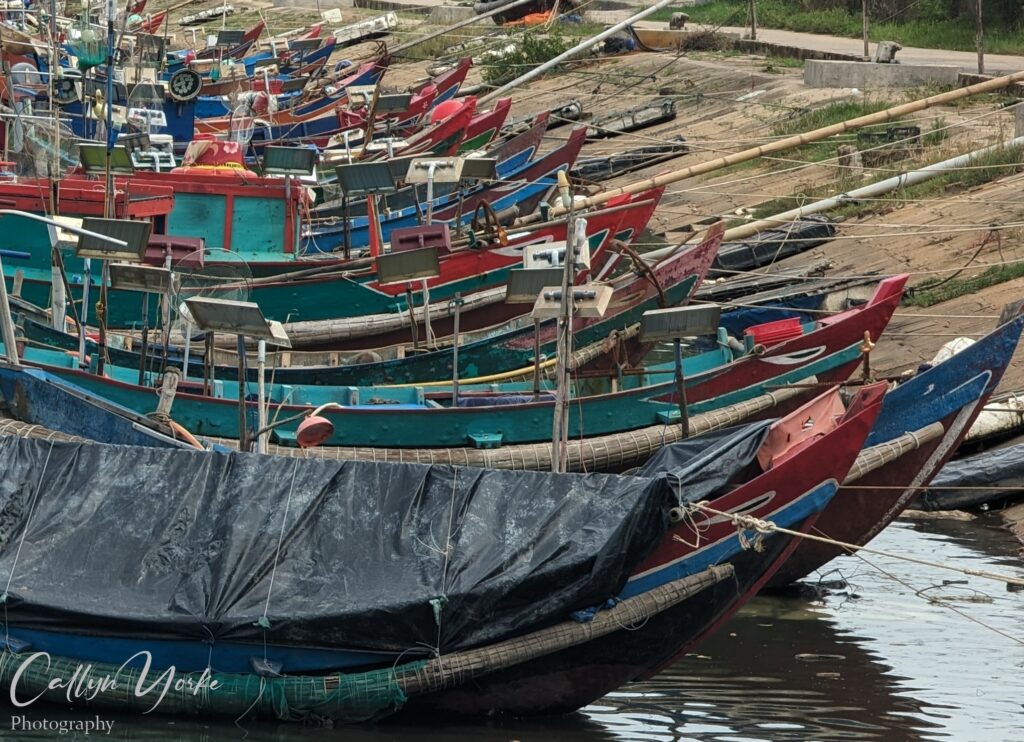
Migratory birds generally require a series of stopovers for rest and refueling. River deltas and coastal estuaries are often used for that purpose. Mudflats, sandbars and beaches at low tide may provide food in the form of marine worms, crustaceans and mollusks. Mangroves are essential fish nurseries and birds such as herons and egrets frequent those habitats. Where natural resources have been removed or modified, birds shift to whatever may be available, including flooded farmland and abandoned aquaculture ponds.
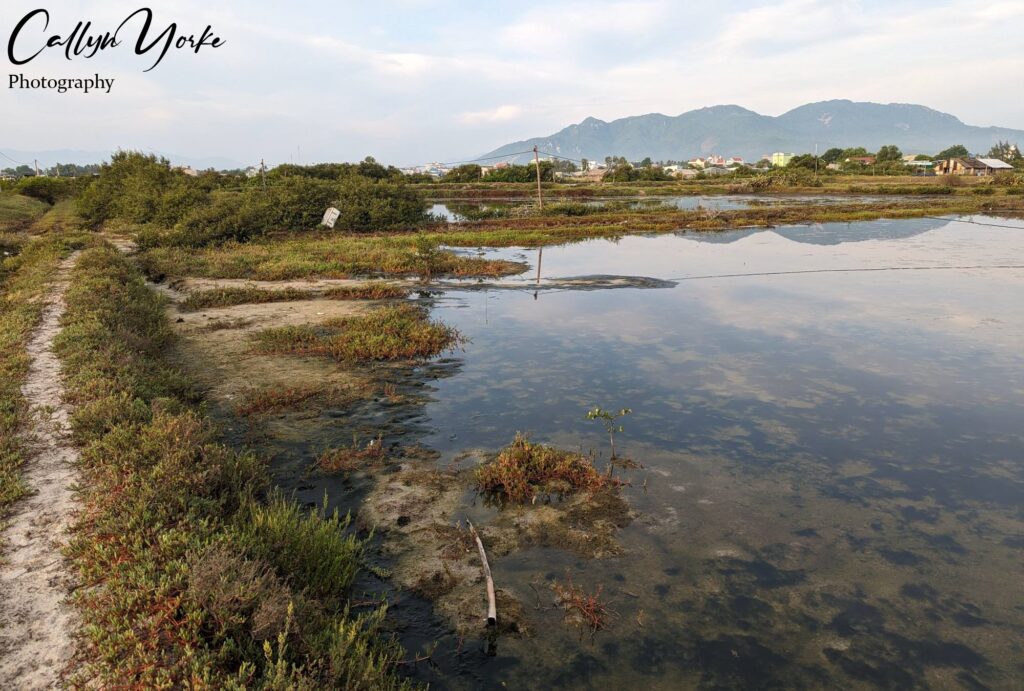
Our coastal surveys included frequent route changes, as potential migratory bird habitat was spotted along highways and backroads. In many instances, we found only a handful of birds in what appeared to be appropriate habitat. Even with optimal low-tide conditions, there was seldom an obvious correlation between habitat quality and bird diversity or abundance. However, we noticed a tendency for migratory shorebirds to favor sites within a kilometer or less of open water, e.g. ocean, bays and lagoons. Wetlands surrounded by adjacent buildings were often devoid of birdlife.
Poaching occurred at nearly all of the places where migratory birds might be found, including paddy fields, lagoons and abandoned aquaculture farms. North of Huế, the use of white decoys for trapping egrets was common. We observed several Intermediate Egrets caught among the decoys, their feet entangled in some sort of ground trap. LQM phoned in the locations of these illegal activities, subsequently handled by local wildlife authorities (photos of the decoys being removed were sent to LQM a few days later). Fortunately, some provinces in Việt Nam, e.g. Thừa Thiên-Huế, have an active department of wildlife protection. We hope that those would be model agencies for all other provinces in Việt Nam.
When we chanced upon a particularly productive area, we altered our travel itinerary in order to provide a reasonably complete accounting of the birds found there. In that way, our coastal survey was more exploratory and opportunistic than it was systematic. Furthermore, given the dynamic nature of development and habitat modification in coastal Việt Nam, it is unlikely that our survey results would be entirely repeatable. Things are changing rapidly in this country; the status and distribution of coastal birds in particular, is in a state of flux.
Survey Methods and Materials
Transportation for the Việt Nam coastal survey was provided by Lê Quý Minh (LQM), who adroitly handled his 2012 Mitsubishi SUV on narrow, congested streets, while navigating with a cell phone. I kept an eye on errant pedestrians, cyclists and motor-bikers. We traveled between cities on the main coast route (with numerous prepaid, nonstop toll gates) and on secondary paved and unpaved rural roads.
We identified potential bird survey sites using satellite images in Google Maps, together with National Geographic printed maps (2012) of North and South Việt Nam (Scale: 1: 650,000). Cell phone images (Google Pixel 7 Pro, CDY) at the principal survey sites included GPS metadata for specific locations on the annotated Google maps used in this report.
Aside from casual observations from the car while in transit, we made walking surveys during frequent stops along the route where the habitat looked promising. Unless an area was fenced and guarded, we entered the property freely and without objections from the locals, except their dogs, which usually barked at us half heartedly then retreated. LQM reassured me that grumpy dogs in Việt Nam understood they could end up on the dinner table.
Sometimes local homeowners were curious and asked what in the world we were doing. LQM always answered politely, engaging them in a friendly conversation. Often, I was asked in broken English, “Wa yo fum?” That was my que for practicing what little Vietnamese I had learned, “Tôi đến từ Mỹ” (I’m from America). I was probably more impressed with my Vietnamese language skills than anyone else present, who winced with painful understanding. LQM provided corrections for pronoun usage and mispronunciations, which were numerous. I usually opened my mouth only to change feet. Fortunately for me, Minh’s English conversational skills were excellent.
Adding a little variety to our routine, we used bicycles once to survey part of Tam Hải Island and a motorboat to reach an isolated lagoon and peninsula in Thu Xá. Each of us carried a binocular (Zeiss 10×42, CDY; Swarovski 8.5×42, LQM) and Nikon digital camera (D850 with a Nikon PF 500mm lens, CDY; Nikon D500 with a Nikon PF 500mm lens, LQM). A Swarovski 80mm 20-60x spotting scope and Gitzo tripod (LQM) were also used for the surveys. I recorded our findings in a pocket-sized field notebook and recopied the information into a loose-leaf binder, handwritten format each evening. Digital photos were reviewed and stored on a hp laptop computer; a USB storage device was used for file backup. My field notes and digital images would subsequently form the basis for this report.
Our surveys began at sunrise and ended at sunset, with varying hours in the vehicle, on foot or stationary. Weather during the surveys was usually fair in the morning, with increasing clouds and occasional intermittent rain in the late afternoon and evening. Ambient air temperature ranged from 26°C to 33°C; winds were variable and generally light (2 -15 kph), frequently from the east and northeast. Afternoon onshore winds put a chop on the ocean surface, while lagoons and river channels remained calm.
Tidal fluctuation followed a predictable six-hour, sliding time scale. However, the amount of exposed shoreline varied considerably from place to place, depending on benthic topography. Because we often began morning surveys at locations many kilometers apart, attention to local tide charts was essential for optimal results. We usually avoided shorelines at high tide, instead spending our time surveying adjacent wetlands and abandoned aquaculture ponds. Presumably, birds were moving around on a similar schedule with ours. High tide was often a period when we found the fewest migratory shorebirds. The whereabouts of most of the birds during those times remained a mystery.
On September 22, after our morning bird survey and breakfast in Cam Ranh Bay, LQM returned home to Huế, a two-day drive for him. The following day, after a final bird survey of abandoned aquaculture ponds in CRB, I took a three-hour taxi ride home to Đà Lạt. According to the odometer on the Mitsubishi SUV, our coastal bird survey while traveling together covered a distance of 1,400 km (see the annotated Việt Nam map above).
Survey Locations, Dates and Times
The following list of our coastal Việt Nam birding locations is in chronological order; Each site where extended observations were made is given an abbreviation used for mapping and in the Annotated Bird List (see the following sections).
Cửa Đại, Hội An, Quảng Nam Province (CD, 13 September, 2023: 1550-1800 hrs.)
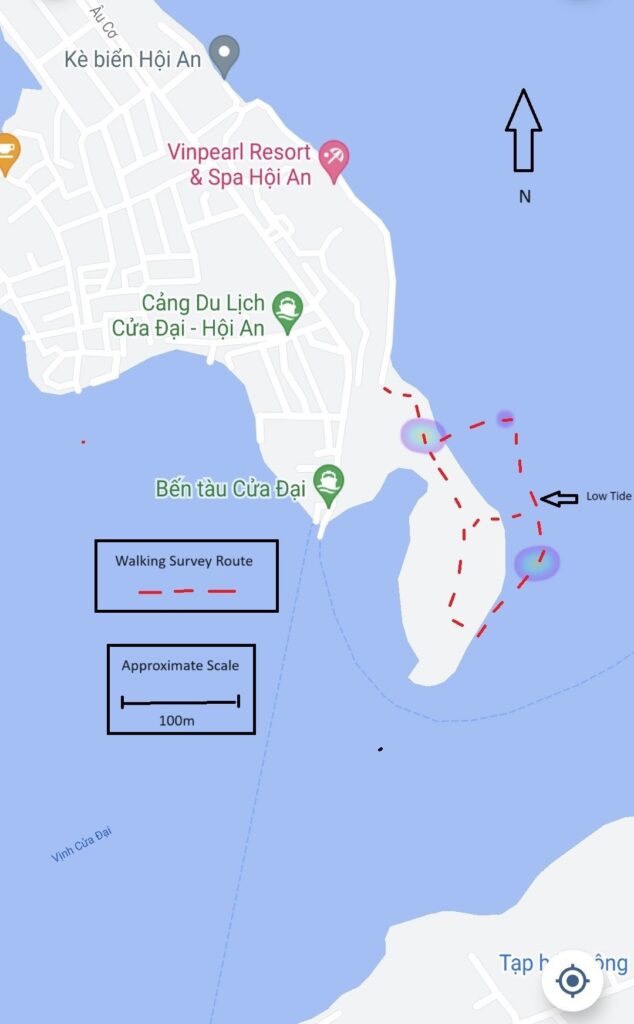
This was our first and one of the most productive migratory bird survey sites we visited. In addition to obtaining images of a vagrant Great Frigatebird circling the estuary, fifteen species of shorebird were tallied, albeit in single-digit numbers. The tide was low during our late afternoon survey, exposing an extensive shoreline; offshore sandbars and mudflats surrounding an interior lagoon, attracted a large variety of shorebird species. Birds moved around continuously due to our presence, as well as the appearance of a few locals and several dogs running freely. Interestingly, foraging sandpipers tolerated dogs at distances well within those that we would expect the birds to be flushed. This suggested that the birds had learned to recognize local dogs and their movements.

Fluttering movement inside a segmented-funnel fish trap caught our attention. Two Ruddy Turnstones had apparently walked into the trap, attracted to the contents. The birds jumped and flapped their wings, panicking when unable to find their way out. LQM walked carefully through the soft mud surrounding the fish trap, photo-documented the birds and freed them from what would surely have been a terminal entrapment. Since this was judged to be an ‘incidental take,‘ i.e. collateral damage from a fish trap, there was no imperative to call in a violation. However, given the widespread usage of these kind of tidal traps in Việt Nam, we were certain that a significant number of migratory birds such as these turnstones, would be among the annual fatalities.
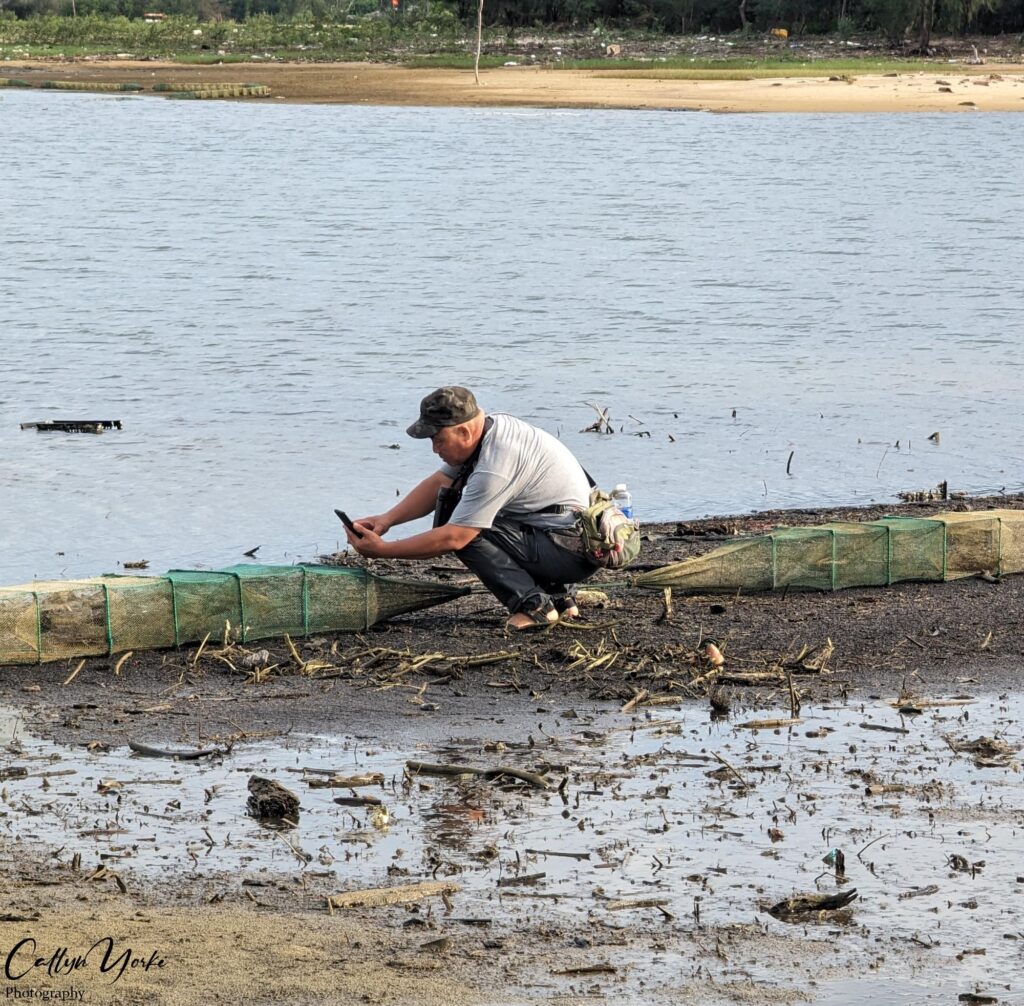
Hải Vân Pass, Thừa Thiên-Huế and Đà Nẵng Provincal border (HVP, 14 September, 2023: 0810-0848 hrs.)
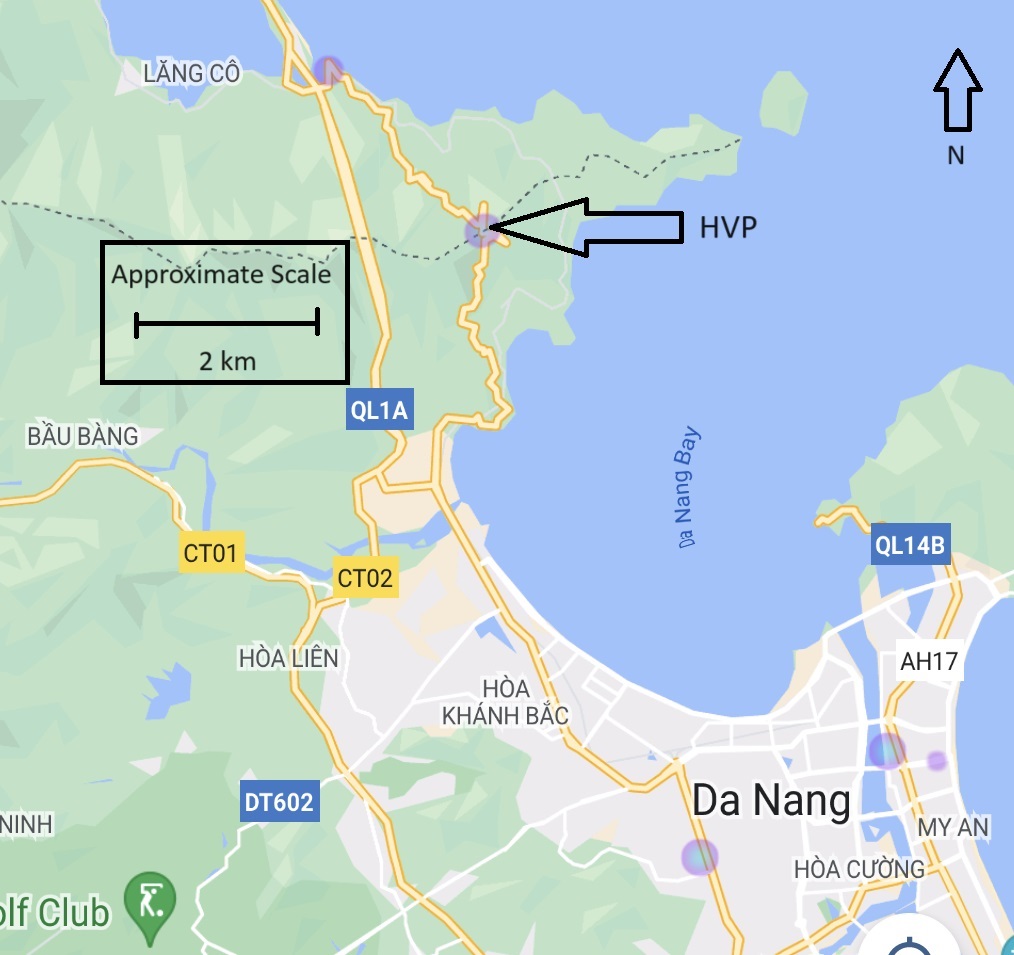
We stopped here briefly for coffee at a roadside cafe along the old HVP road. An outdoor seating area looked as if it had been designed for visiting birders. The weather was fair, WNW winds 2-5 kph, and we had a mostly unobstructed view in all directions. If any migratory birds came through the pass (elevation, 500m), we probably would have seen them. However, only resident birds were found there during our visit. About the only noteworthy findings were, according to LQM, two closely related bulbuls, Northern Sooty-headed Bulbul (Pycnonotus chrysorrhoides) and Southern Sooty-headed Bulbul (P. aurigaster), being allopatric at Hải Vân Pass; we were seeing P. aurigaster on the south slope of the pass and P. chrysorrhoides on the north slope.
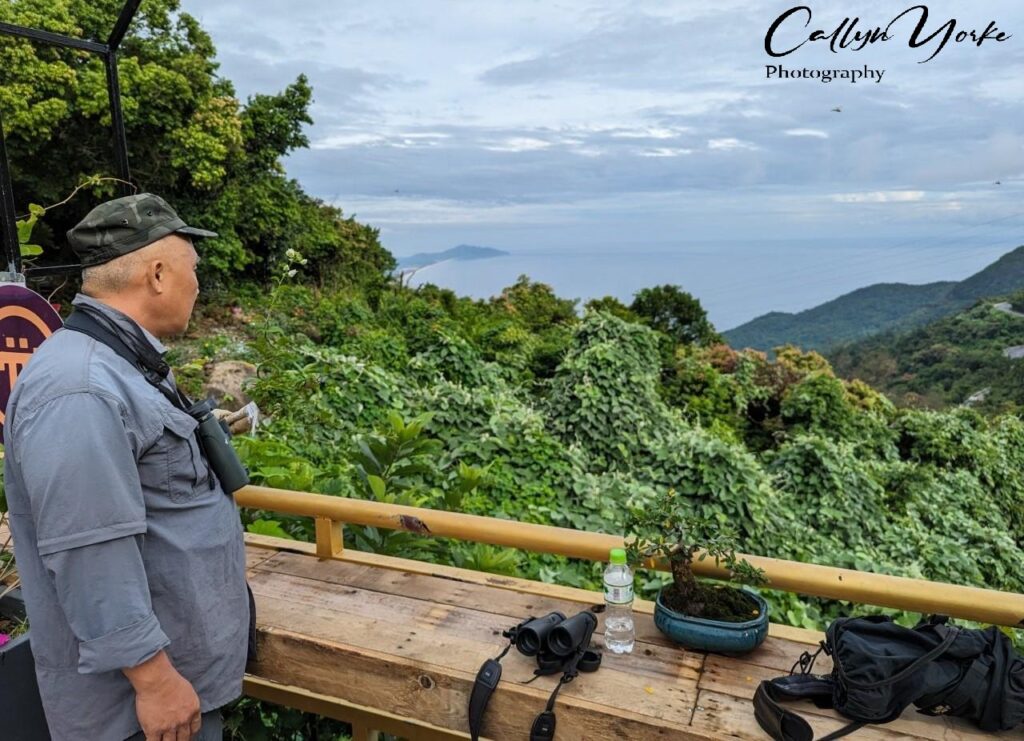
For viewing migrants, Minh suggested that we make an early morning visit to HVP on our return trip southward. Unfortunately, that opportunity wouldn’t be available, mainly due to the great distance we subsequently needed to drive in order to reach coastal locations in the southern portion of Việt Nam. Our southbound route would use the new highway and tunnel connecting with the Đà Nẵng bypass.
Judging by its prominent geographical position on the coast, Hải Vân Pass is probably a significant migratory corridor in Spring and Autumn and I expect it would be interesting to spend several consecutive mornings there, particularly during stormy periods. Since there is no available lodging at HVP, a pre-dawn departure from either Lăng Cô or Đà Nẵng, would be logistical options.
Lăng Cô and Cầu Bù Lu, Đầm Cầu Hai, Thừa Thiên-Huế Province (LCO; CBL, 14 September, 2023: 0910-1130 hrs.)

We made a series of brief stops and stationary observations at roadside pastures with ponds and wetlands, patchily bordered by exotic Eucalyptus and Acacia plantation trees, coastal scrub and weedy second-growth. About a dozen head of cattle were present at one location in the LCO area; whereas the CBL lagoon and Đầm Cầu Hai areas were comparatively quiet and undisturbed. Heavy rain began shortly after we surveyed the area and stopped for lunch at a local cafe.
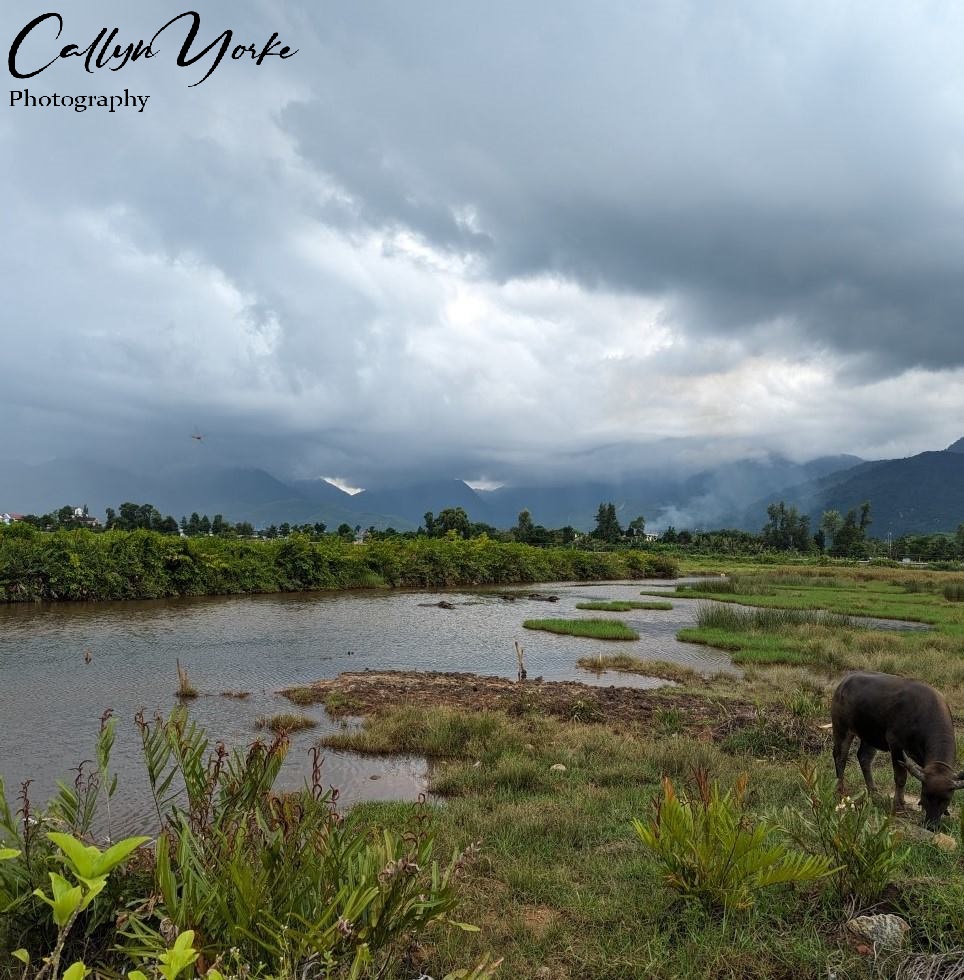
Migratory waterbirds found during multiple stops in this area, included, Slaty-legged Crake, Chinese Pond Heron, Eastern Cattle Egret, Intermediate Egret, Common Sandpiper and Common Greenshank; resident species we found were, Cinnamon Bittern, Black-necked Lapwing and six Yellow-legged Buttonquail crossing the road. Blue-tailed Bee-eater was abundant and presumably nested in the area; the local population possibly augmented in Autumn by passage migrants.
Greater Huế: Thuận An, Cửa Hương, Thừa Thiên-Huế Province (14-15 September, 2023)
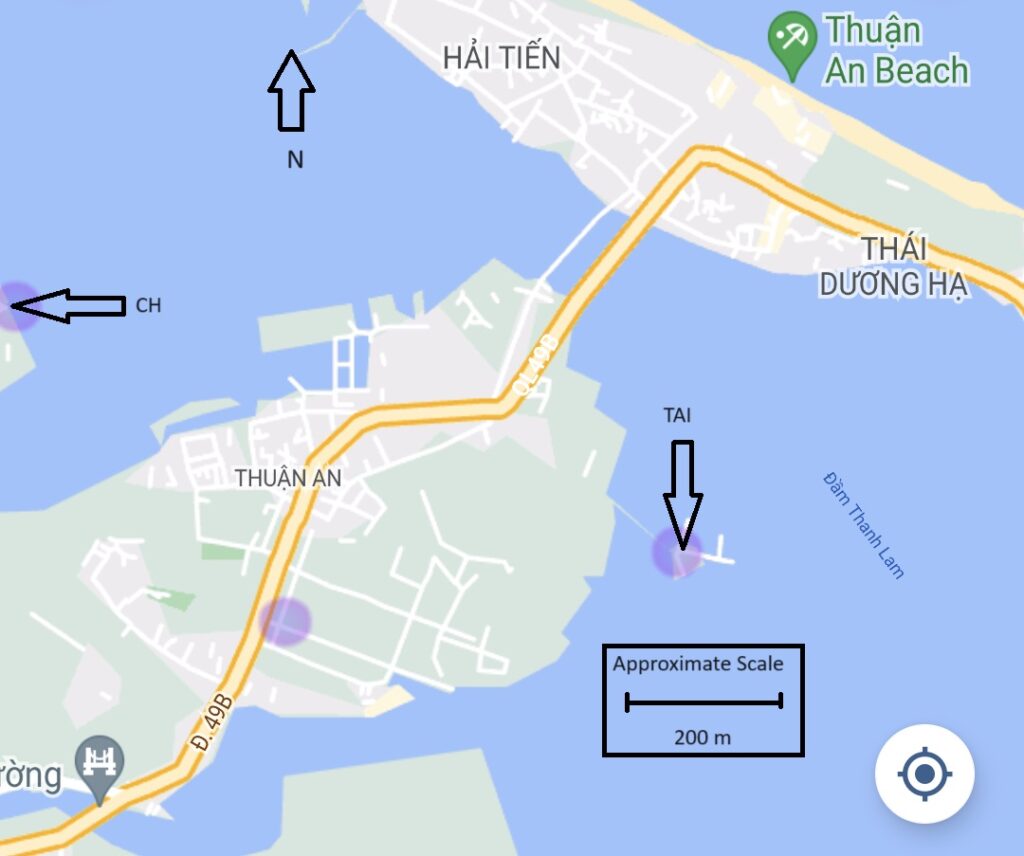
Using a hotel in central Huế as an overnight base, we made afternoon (14 September) and morning (15 September) stops on a backroad tour of the greater Huế area, including flooded paddy fields, active and abandoned aquaculture ponds, villages and wetlands adjacent to Cửa Hương (mouth of the Perfume River).
This was the rural area that Minh grew up in and he knew it well. As a curious foreigner, I was in for a special treat. Huế is arguably still the heart of Việt Nam, where many folks live a traditional lifestyle in a bucolic setting. Scenic splendor is everywhere. Embracing the city and ancient Citadel, is the legendary Sông Hương (Perfume River), originating somewhere among the distant, dark ridges of the Dãy Trường Sơn; flowing steadily to the sea like a glistening golden serpent.
Of course, all of this was deeply familiar to Minh. His parents, both in their 90’s, had recently passed away and Minh was still quietly processing the loss.
“Over there, across the field, behind that large palm, is my mother’s house,” he said, clearing his throat. “I rode my bicycle on these village roads.”
Indeed, Huế was a place I would have cherished as a boy, as Minh described, wandering about, exploring every forest, field and waterway. And even today, amidst all the changes accompanying modern life, Huế works its magic.
“You know, Minh, if I had come to Huế first, instead of Đà Lạt, I might well have settled here. This is Việt Nam, as I imagined it would be.”

Minh, who in side profile, sometimes resembled the 14th Dalai Lama, smiled and nodded. We continued on a narrow, dirt road separating walled gardens bursting with bougainvillea, mango and papaya trees. Mostly, there were traditional clay-brick houses with mottled terra cotta tile roofing, weathering through generations of occupants. We drove on in silence. I stared out the car window, lulled into a daydream. I believed Minh understood the spell Huế was casting over me.
In addition to finding a couple of delightful birding spots in the area, I thoroughly enjoyed the enchanting milieu of Huế, its authentic Vietnamese culture and delicious food, e.g. Phở Bò (beef noodle soup) and Bánh tráng cuốn thịt leo (rice paper wrapped spring roll with lettuce and pork). Celebrating the end of our day with a mug of cold Tiger Beer, Yo, I was in heaven.
As a diligent field Ornithologist, I asked if we might sample more of the famous Huế cuisine, particularly roasted duck. For reasons Minh found difficult to explain, that food item wouldn’t be available during our visit. If he was unsure of the reason, I would certainly be unable to figure it out. Huế paddy fields were crawling with domestic ducks. Something didn’t quite add up.
The Vietnamese have a complicated system for scheduling events. Be it a wedding, divorce, funeral, airline flight or special meal, the timing must be absolutely correct. Maybe the moon was in the wrong phase for consuming duck. I was a little bummed. As a consolation prize, I suppose, there was an opportunity for some National Geographic-style photos of local duck farmers herding leucistic mallards to their overnight pen. Here’s a link to my video of that lively event.
We checked out of the hotel in Huế after an early breakfast and drove toward the coast. The tide was high and it appeared unlikely we would see many shorebirds at the river mouth. We took a side road (Võ Trường Tỏan) on the edge of town and parked at the end of an unnamed, potholed road facing an island of aquaculture ponds interconnected by levee trails (TAI). We didn’t find much birdlife and continued walking toward a relatively heavily vegetated area with unused ponds. It was sunny and warming quickly. Most of the resident land birds, e.g. Masked Laughingthrush and Plain Prinia, had retreated to the shade of shrubs and isolated trees. Except for Common Sandpiper, migratory shorebirds were evidently absent at this location.
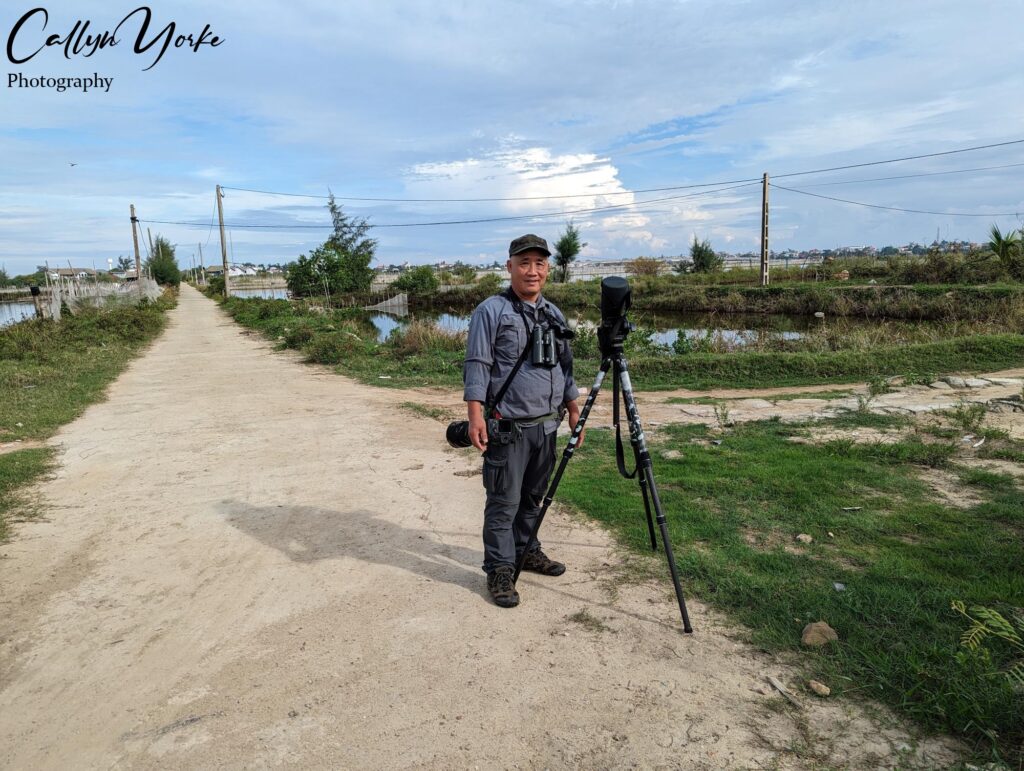
We noticed movement at the edge of one of the ponds. Minh and I had glass on it instantly. A fairly robust rail with a long, orangish-colored bill, was running for cover, a characteristic behavior of those furtive birds. We waited to see if it might reappear. Instead, two more individuals, about the same size but with slightly paler (i.e. immature) plumage quickly darted from the edge of the pond and disappeared into the same, dense cover. Minh and I moved over to where we had a clear view of a dirt road, separating the rail hiding spot from dense vegetation on the other side. We guessed, correctly, that the birds would soon be scurrying across the road. Focusing our cameras on the spot they would likely cross, we braced ourselves for the ambush. Within a few minutes the birds came out, one at a time. We fired off multiple shots and got identifiable digital images; mine, mostly of an immature bird. The third individual apparently escaped, undocumented. At the time, neither of us were sure of the bird’s specific identity. There were really only two possibilities, one of them being quite exciting, though highly unlikely.
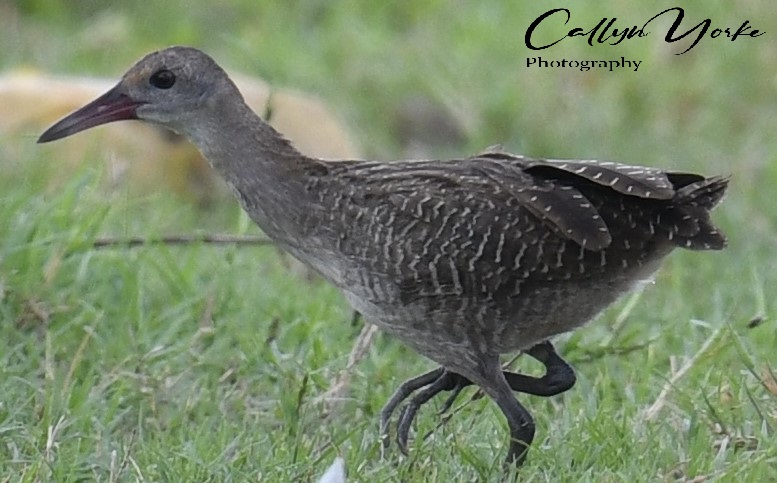
That evening, I reviewed my digital images on the laptop and compared them with online images and published descriptions of similar species of rail, e.g. Eastern Water Rail (Rallus indicus), a rare winter visitor in northeastern Việt Nam, and the widespread, fairly common, Slaty-breasted Rail. The latter rail species was clearly the best match, based on several morphological features, i.e., overall size, shape and plumage; bill structure and color. Once again, ancient wisdom found in the Principle of Parsimony, provided a valuable lesson in bird identification.
We were definitely warmed up, in fact, sweating completely through our clothes, and ready to continue exploring the nearby riverside area to the northwest. At Cửa Hương (CH) – the mouth of the main channel of the Perfume River (see preceeding map) – we found a pair abandoned aquaculture ponds with just the right amount of water and mud to attract a variety of migratory shorebirds at high tide. Next to a road, about 70m from the ponds, an old concrete military bunker and tattered fish net, provided a makeshift hide. There, we spent about 1.5 hr. scoping the birds coming and going from the ponds. It was by far the best shorebird location we had found north of Cửa Đại.
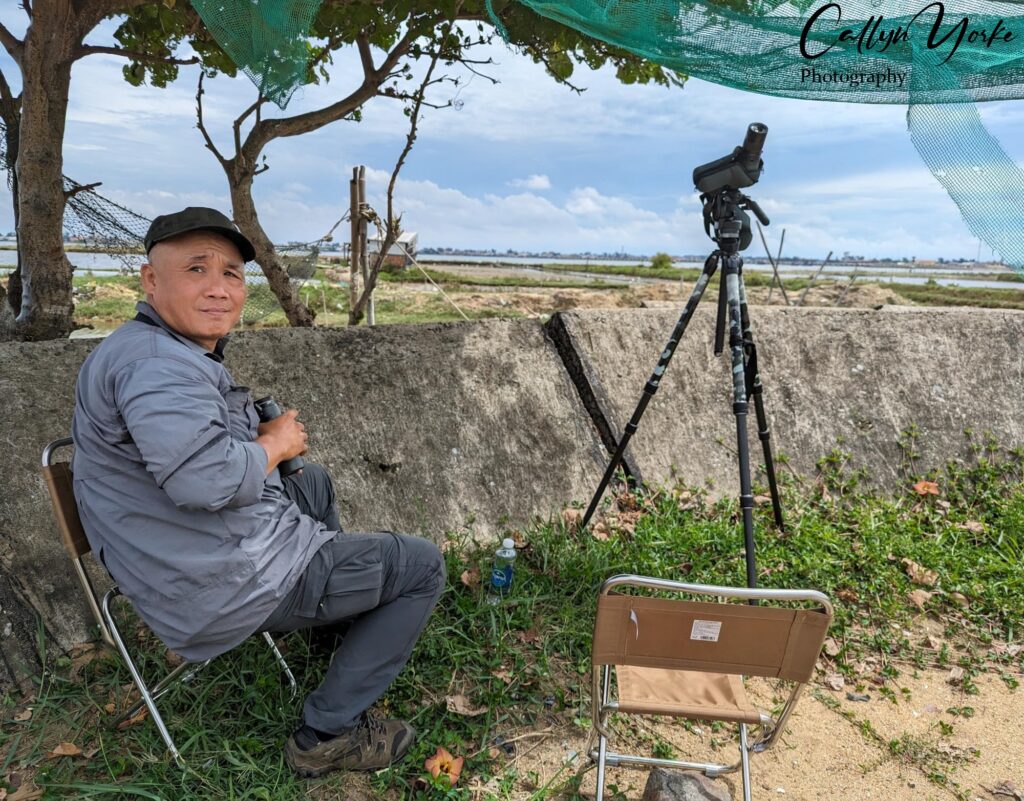
17th Parallel: Cửa Việt, Cửa Tùng, Mũi Si, Quảng Trị Province (CV; CTU; MS, 16 September, 2023)

We stopped at a few locations along the historic La Rue Sans Joie (Street Without Joy) while heading northward from Huế, with extended walks on the shorelines at Cửa Việt and Cửa Tùng. We booked an overnight stay at the scenic cliffs of Mũi Si, south of Cape Lay and the famous Vịnh Mốc tunnel complex. We spent about two hours in the late afternoon exploring the coastal scrub and shoreline area on foot. This was the northernmost site included in our coastal survey and was comparatively unproductive for migratory birds.
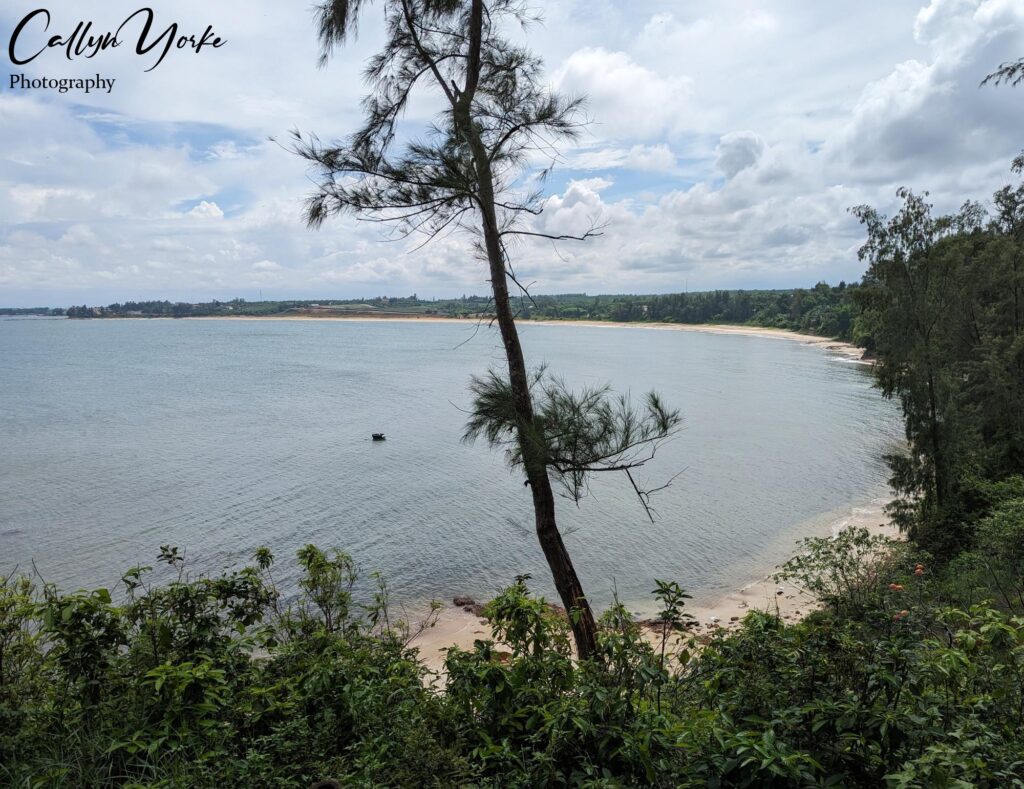
Only at Cửa Tùng, on the shoreline close to the 17th Parallel, did we find something especially noteworthy — fresh tracks of the Great Thicknee, a bird of uncertain status in Vietnam. We had been searching for this bird throughout our coastal expedition. Some years earlier in Cam Ranh Bay, I had found a viable population of Great Thicknee, and learned to identify its distinctive tracks. Now that Minh was familiar with Great Thicknee tracks, we redoubled our efforts to document shoreline locations where this bird still occurred.

At sunrise the following morning, after checking out of a homestay at Mũi Si, we returned to the Cửa Tùng site to search further for Great Thicknee. Unfortunately, the shoreline was already occupied by locals and we decided to continue our drive southward. Eventually, we would find Great Thicknee tracks at two more locations and photo-document their owners in Thu Xá (see Annotated Bird List).
Our decision to return southward along the coast was based on what appeared to be a decreasing number of migratory shorebirds north of Huế. Although this may have been due simply to our lack of attention to appropriate habitats and tide schedules, we judged that our time might be better spent searching coastal estuaries and wetlands further south, where shorebirds were comparatively abundant in autumn and winter months, e.g. Cam Ranh Bay. Furthermore, I had recently observed significant numbers of Asian shorebirds on the north coast of Borneo in the middle of August. Thus, it seemed quite possible that the south-central coast of Vietnam would have more migratory shorebirds in mid-September than would the north-central coast.
Tam Hải Island, Quảng Nam Province (TH, 17-18 September 2023)
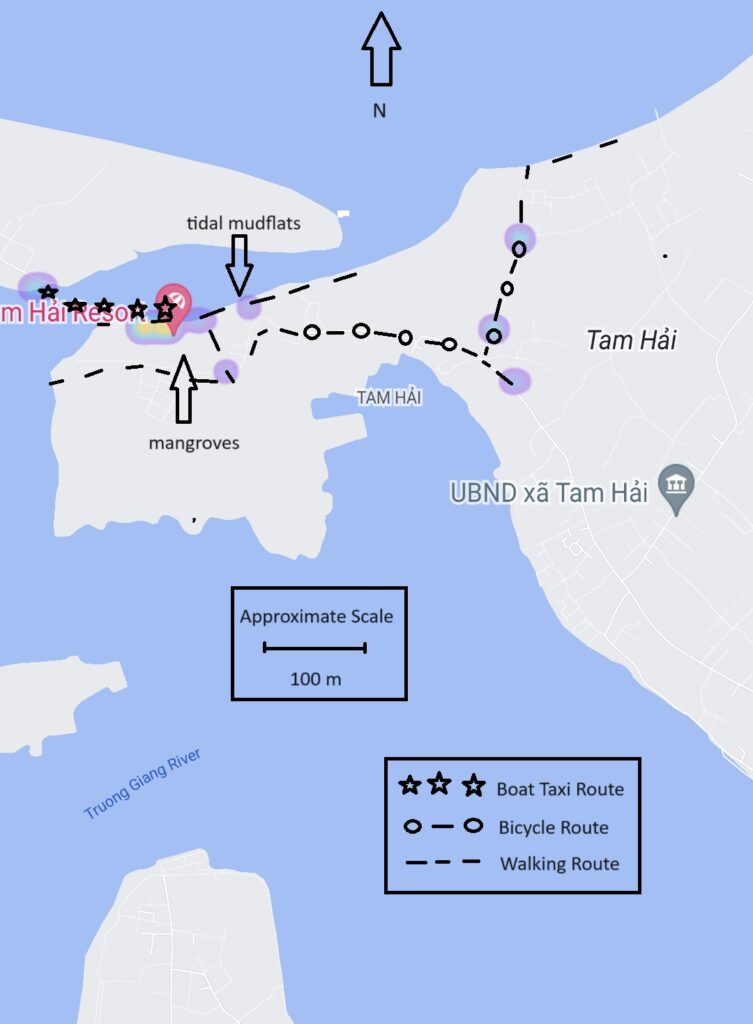
Our next destination was Tam Hải Island, Quảng Nam, about a five-hour drive (270 km) south of Cửa Tùng. Minh called ahead to arrange a motorboat taxi to the Domaine Resort on Tam Hải Island. There we would be the only resort guests on the second consecutive day, while exploring the local mudflats, mangrove and outer shore.

This area, though heavily used by local fishermen, including incessant dredging of the channel for benthic gastropods sold to shrimp farmers, was a moderately productive site for migratory shorebirds. Behind the resort, there was a small but relatively undisturbed patch of mangrove. This was the only significant stand of mature mangrove we would encounter during the coastal survey.

Waterbirds we found on Tam Hải Island, all in single digit numbers, were Striated Heron, Greater Sandplover, Lesser Sandplover, White-faced Plover, Terek Sandpiper, Wood Sandpiper, Whimbrel, Sanderling, Whiskered Tern, Greater Crested Tern, Common Kingfisher, Pied Kingfisher, and White-breasted Kingfisher. Although the outer shoreline habitat on Tam Hải island appeared suitable, we found no sign there of Great Thicknee.
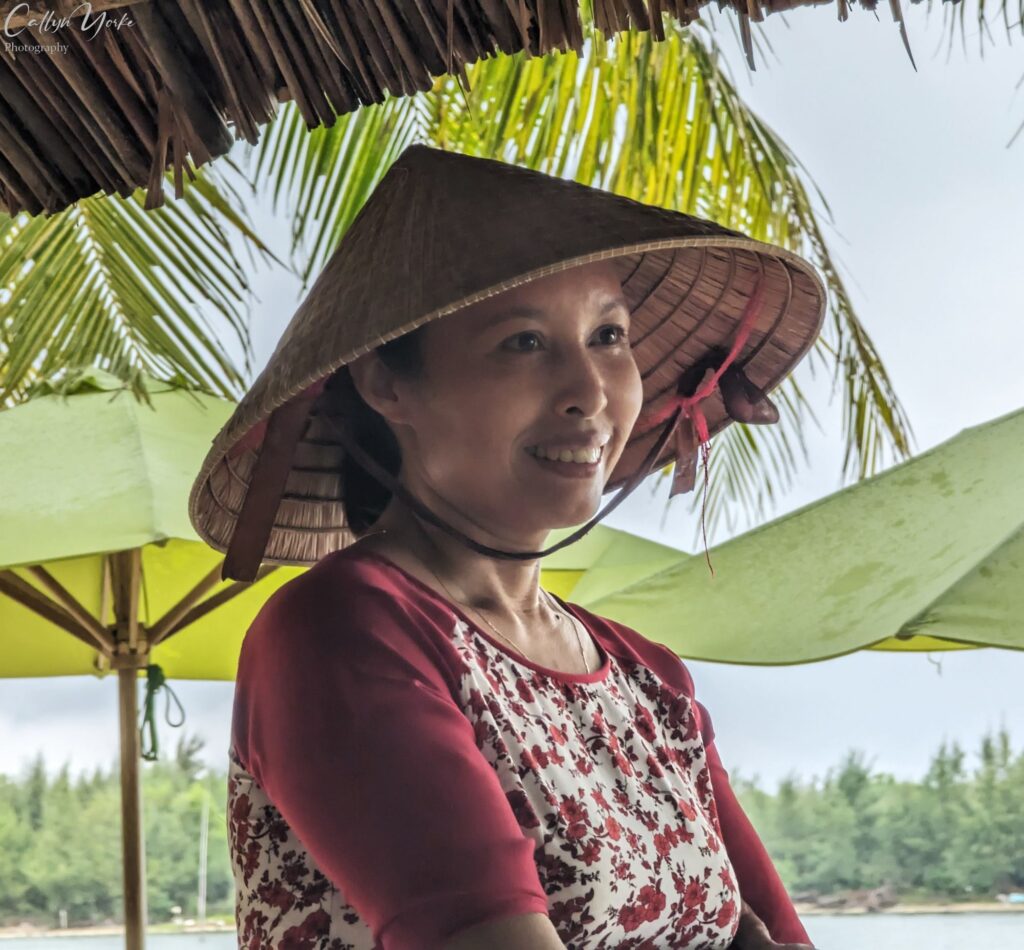
Mỹ Lai; Thu Xá, Quảng Ngãi Province (ML; TX, 18-20 September, 2023)

There was a small notation in red print on the Nat. Geo. map, indicating the location of the Mỹ Lai memorial. Since the site wasn’t far off the coastal route we were on, I asked Minh if we could stop there for a brief visit. He was a little uneasy with the request but eventually approved it. He said that he had been to the place many years ago.
Continuing southward on the main coastal highway, we took the turn-off near the district capitol of Sơn Tịnh, then drove several more kilometers to the village of Tịnh Khê. Historically, Mỹ Lai was a four-part subdivision of the larger village of Sơn Mỹ. The National Monument, established in 1978 and upgraded in 2003, carried that name, rather than Mỹ Lai, used by the American news media when breaking the horrific story.
Unfamiliar with the new memorial facility, Minh drove past it and stopped to ask a boy on a bicycle if he knew where it was. He certainly did and directed us to the entrance. The Sơn Mỹ National Monument, included an entry gate, parking area, ticket office, guest register, auditorium, documentary film, museum, partially reconstructed hamlet of Mỹ Lai and graveyard for the victims.
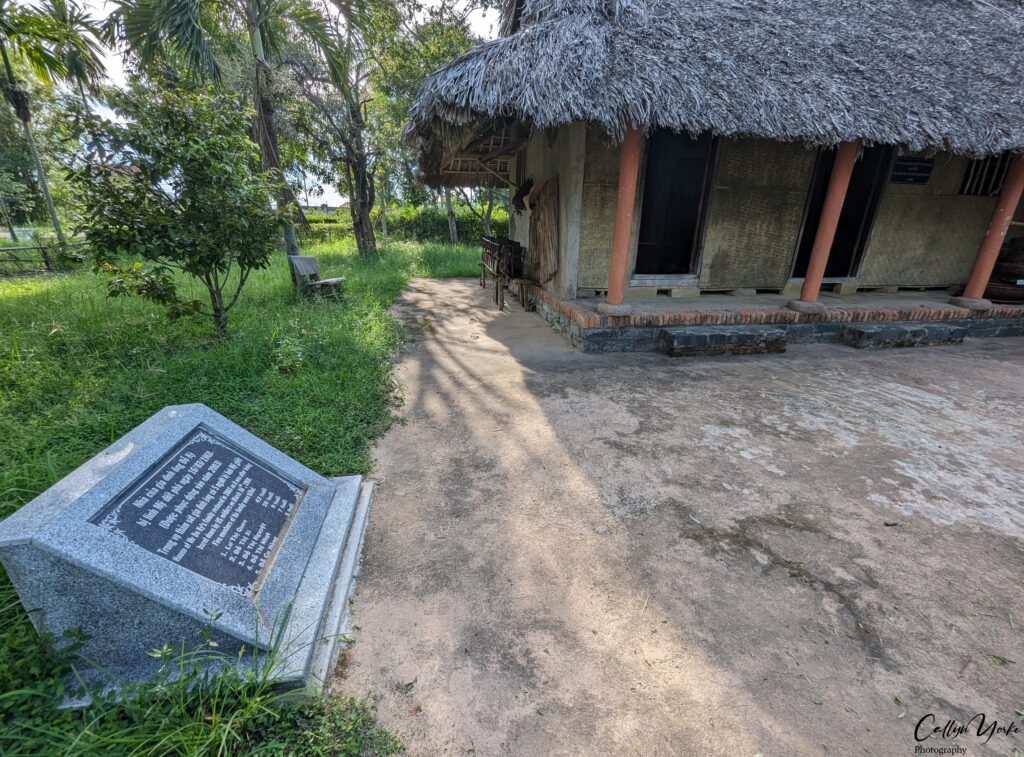
Upon arrival we were apparently the only visitors in Mỹ Lai. The silence was as intense as the coastal heat and humidity; a poignant reminder of the massive tragedy that had taken place. There was a strange, haunting feeling that gripped me. Perhaps this was why Minh had reluctantly agreed to come here. The Vietnamese, who dutifully respect their ancestral heritage and acknowledge the presence of multiple spirits, each with specific oversight on aspects of daily life, were familiar with such feelings. Obviously for them, there were unrequited spirits in Mỹ Lai. Maybe they were right about that.
I purchased a ticket at the entrance from a pleasant, English-speaking Vietnamese woman. She offered an information pamphlet for sale that I politely declined. Enough homework had been done on Mỹ Lai. Shelve the books, this was the real deal.
Minh and I ascended a stairway to the museum. Two Vietnamese women were sitting on the floor, preparing offerings. Graphic photos of the Mỹ Lai victims were separated from a collection of military portraits of the perpetrators and their commanding officers. Framed first-person testimonials drove the message home. It was difficult to hold back the tears.
I guessed we had spent about an hour at the Mỹ Lai monument, which included a stroll though the graveyard and re-created homestead. A bullet riddled coconut palm, evidently of some antiquity, was among the few surviving witnesses to the murder of hundreds of unarmed Vietnamese men, women and children, by an American Army infantry unit in 1968.
Vietnamese workers at the monument learned that I was an American and asked if I was a veteran. Minh, speaking in Vietnamese, told them the truth, that I had been a student during the Vietnam War years. I still felt like I was walking around with a scarlet letter on my forehead.
Apparently, quite a few Vietnam War veterans have visited this memorial, including at least one American soldier who was present during the massacre. He was interviewed in the concluding segment of a Al Jazeera film, screened for us in the auditorium. Minh and I were the only visitors in the audience.
The US Army veteran, now in his 70’s, appeared stoic, yet pensive. This was his voluntary, cathartic tribunal. He was repeatedly apologetic to a Vietnamese man who, as a young boy was shot in the head during the Mỹ Lai massacre. His family had not survived.
Could this repentant man be forgiven for what he had done as a young soldier? The Vietnamese man, bearing a disfiguring scar on the side of his face, said perhaps so, though he couldn’t escape the anger and rage sitting next to a person who may have been the one who killed his family.
By the end of the expository documentary, I had nearly reached the limit of emotional endurance. Minh and I went outside for air.
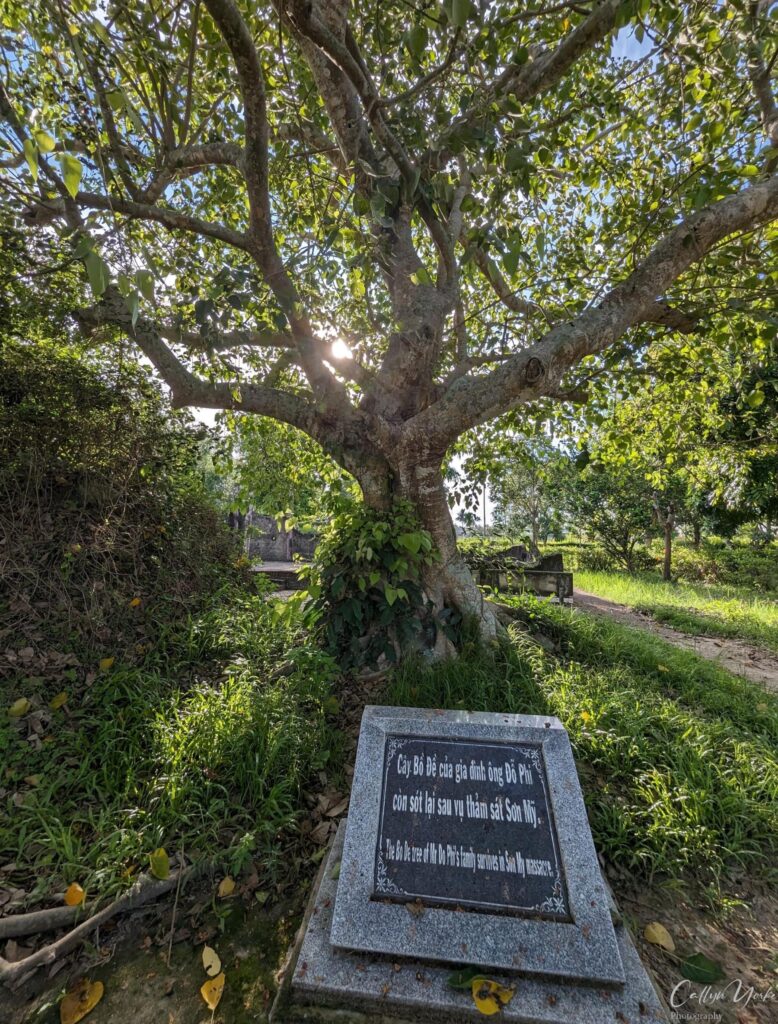
Afterwards, while Minh spoke with the receptionist, I sat down in the shade of a buttressed strangler fig and tried to process what I had seen in the Mỹ Lai memorial. Reading about the incident many years ago, I was shocked and angered. It was additional fuel for wildfires of dissent that swept across the country in those days.
Here, deep in the soil of a Vietnamese village, where the awful, four-hour event occurred, were the remains of those poor people; their screams lost in the wind. The grim reality put me in contact with unsettled feelings I had as a student protestor, though now, in an unspeakably profound way. My thoughts were spinning with unanswered, perhaps unanswerable questions. How could our American boys have committed such an atrocity? The returning American Army veteran interviewed in the film had no credible explanation besides, “We were young and just following orders.”

Nearby, a family of Streak-eared Bulbuls chattered, hidden in the foliage of a large tree. I wondered if those were among the last familiar sounds heard by the villagers of Mỹ Lai, as they awoke on the morning of March 16, 1968.
Thu Xá, Quảng Ngãi Province (TX, 18-20 September, 2023)

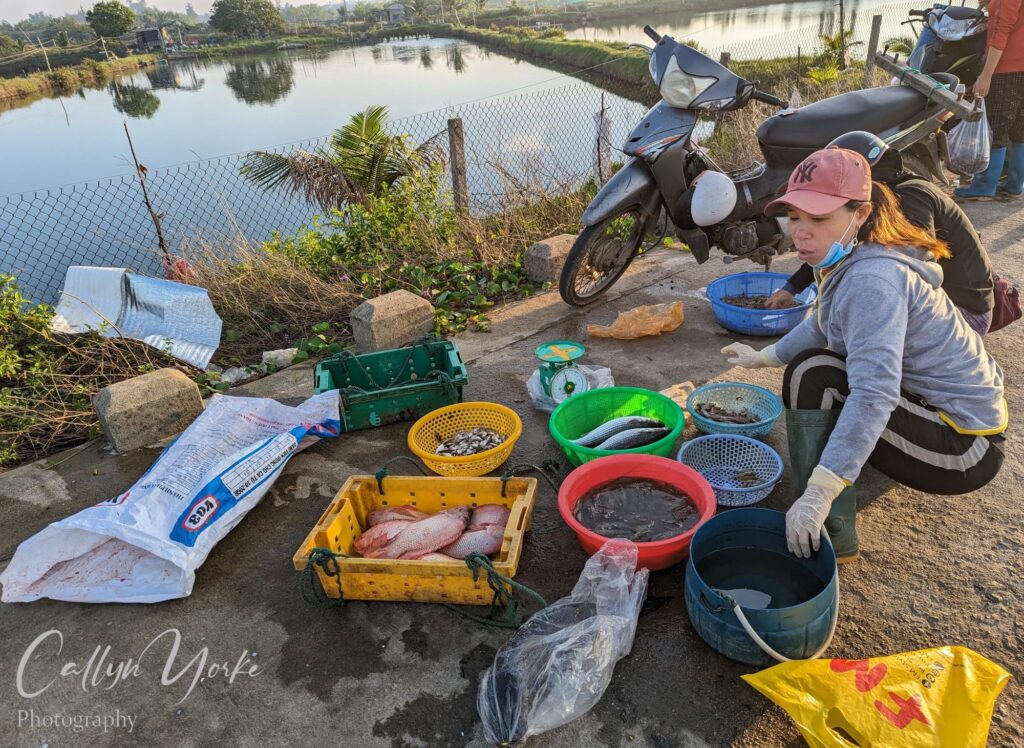
As with most of the lodging places where we stayed, other guests were scarcer than shorebirds at high tide. We had the sixty-eight villas of CocoLand River Beach Resort largely to ourselves for two days. Of course, that meant the kitchen was essentially closed and we had to go elsewhere for our meals. Aside from empty riverside restaurants and a village street market, there weren’t many food options. Wisely, Minh had brought several pomelos from his garden, and along with a bunch of bananas purchased on the roadside, we managed to survive the slim pickings in Thu Xá.

The location of the resort on the Vực Hồng River, was otherwise perfect for us. We had good birding results walking the levee road outside the resort at sunrise and sunset. At low tide, the mud-and-rock shorelines were productive. There, we observed mixed flocks of shorebirds at close range, e.g. Little-ringed Plover, Ruddy Turnstone, Terek Sandpiper and Whimbrel. At dusk, Minh identified the vocalizations of an Eastern Barn Owl, which flew low over the lagoon, and disappeared into the darkness. I had only a brief, dim view of the bird in flight, and could see that it was a barn owl (Tyto alba). The barn owl form occurring in this region is considered by some authorities to be specifically distinct from the Western Barn Owl, familiar to many rural Americans. Missing the key distinctions, I was reluctant to count this one as a life bird.
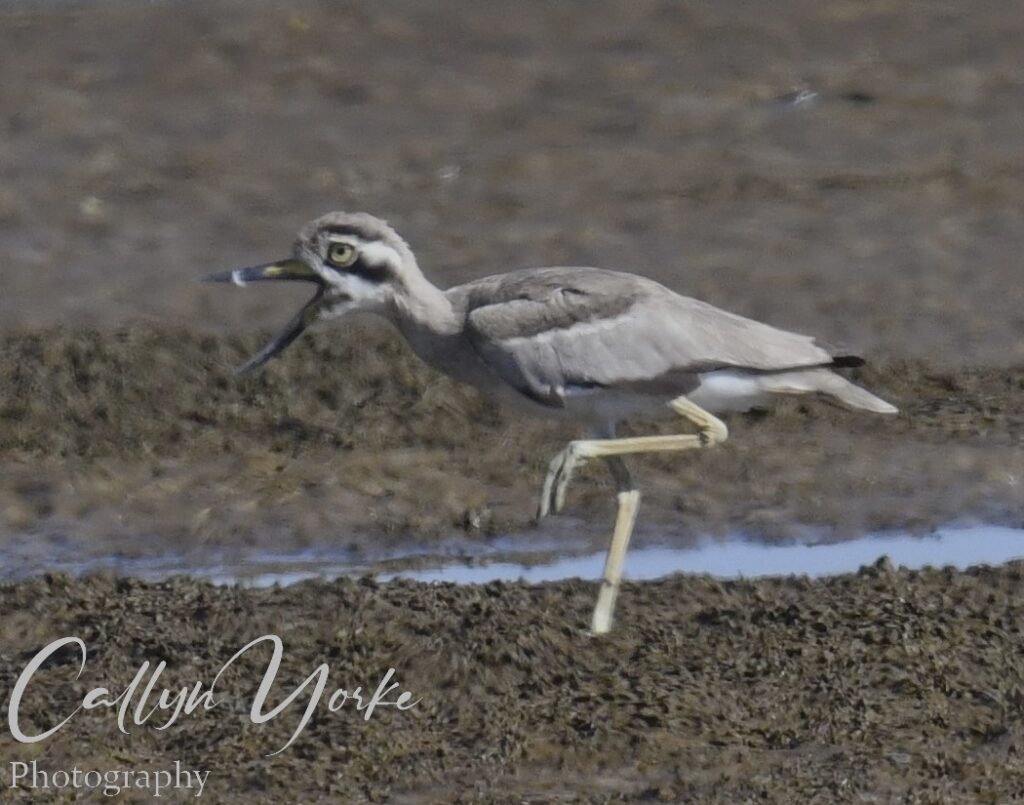
The real prize was on a distant sandbar, our bird-most-wanted, Great Thicknee. Minh and I simultaneously had glass on it. The following morning we chartered a water taxi to the sandbar peninsula. There, we tracked down and photographed two of the birds, an adult and immature. High fives on that one. On the return boat trip, we switched water taxis at another dock, and found our first and only Black-tailed Godwit on the far shore. That little boat trip turned out to be one of the highlights of our coastal bird survey.
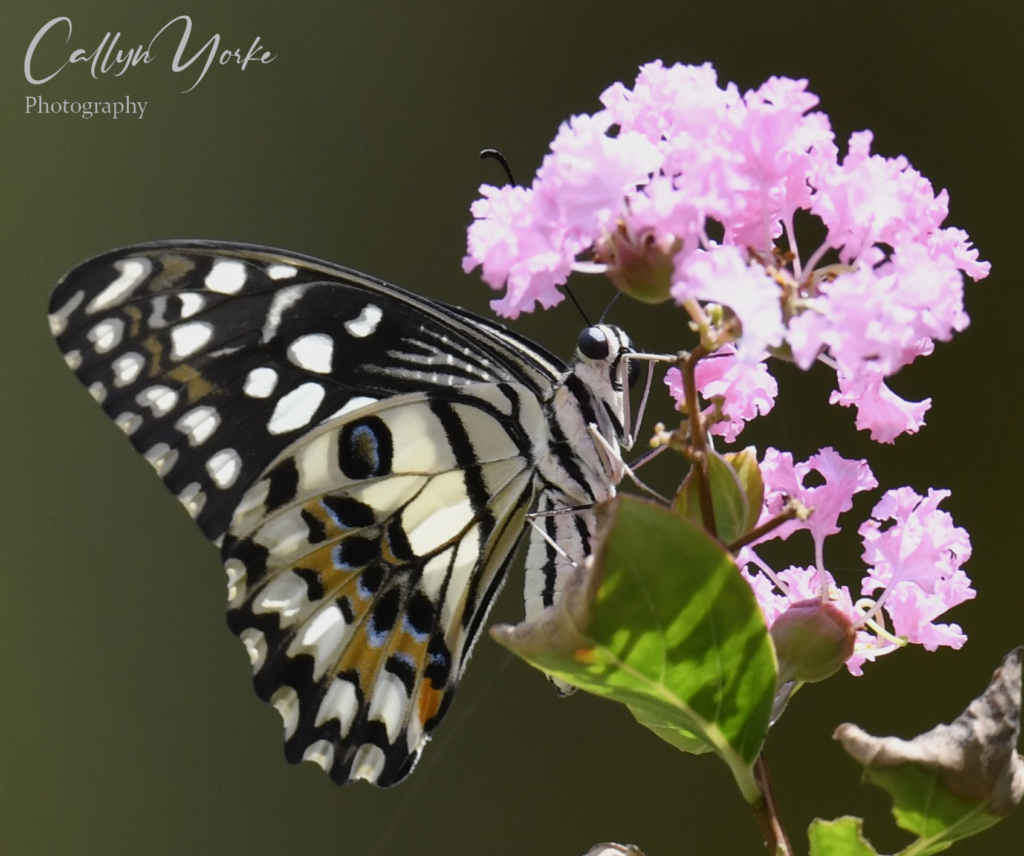
Our visit to Thu Xá, included a short drive to a nearby farming village, where we walked for three hours on pathways through the paddy fields bordered by coastal scrub. Near the end of our walk to a riverbank, we found a dozen or so egrets in a coppice of tall Eucalyptus. This may have been an important evening roost for the widespread flocks of Intermediate Egret and Eastern Cattle Egret, frequenting paddy fields during the day.

Tuy Hòa, Phú Yên Province (TH, 21 September, 2023: 0530-0630 hrs.)
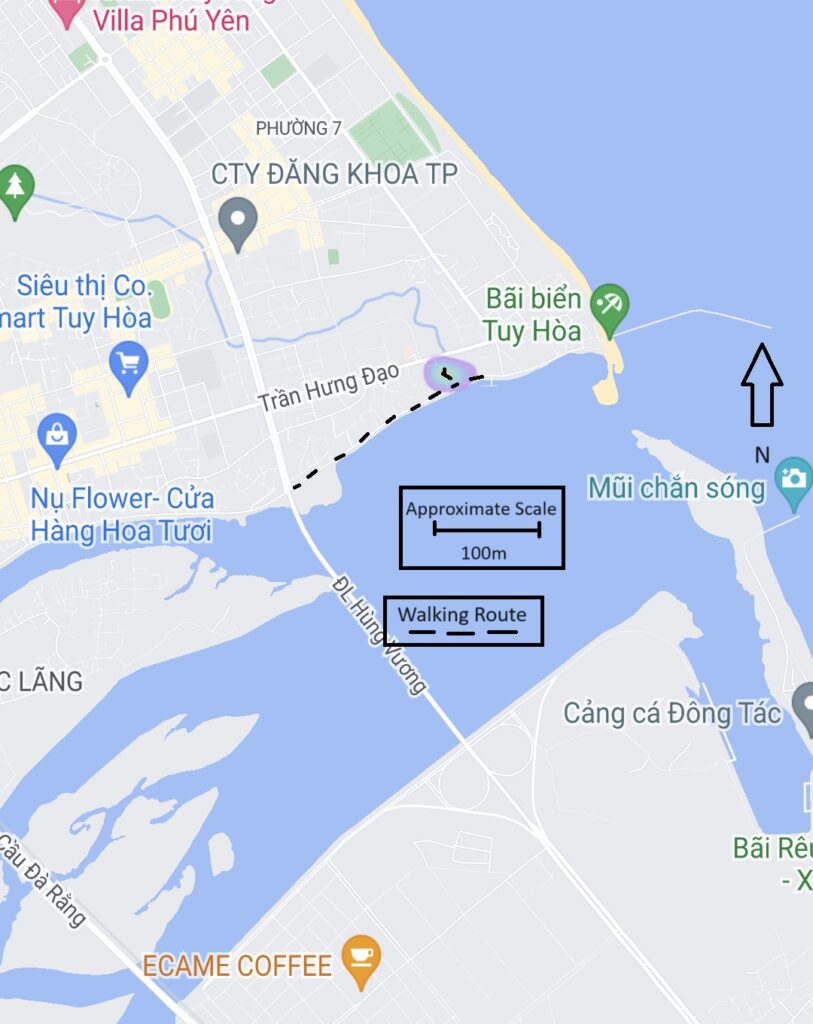
Darkness had fallen by the time we reached a riverfront hotel in Tuy Hòa on Wednesday, September 20, 2023. We would make a sunrise survey of the waterfront the following day.
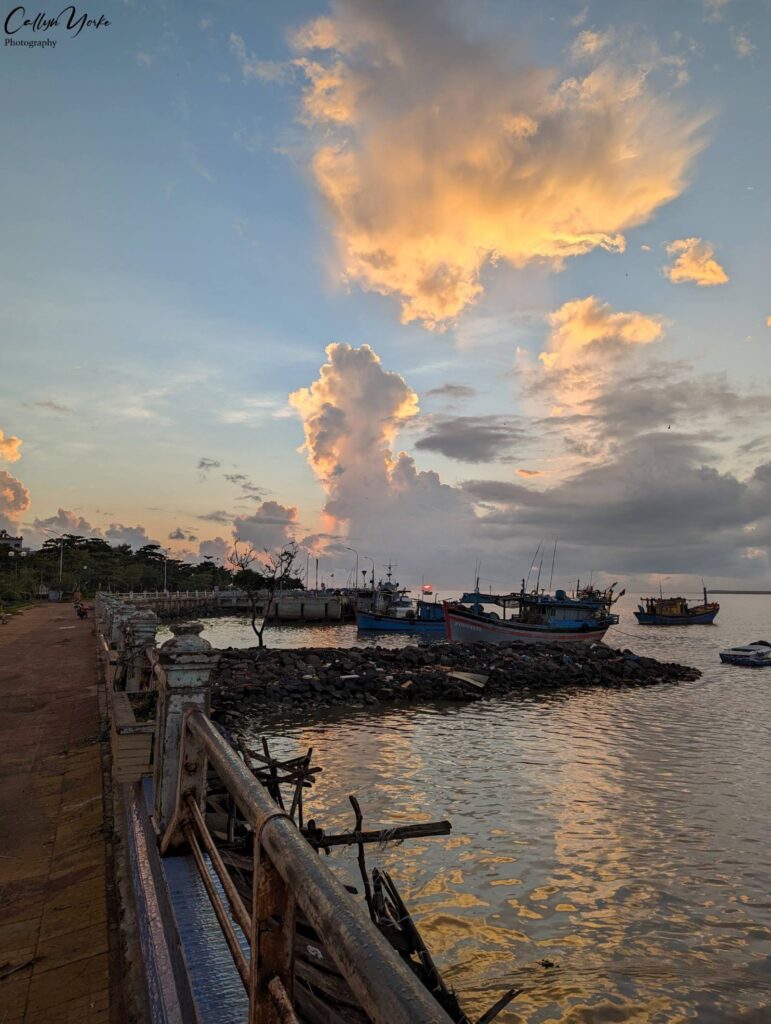
Our dawn survey, beginning at the Tuy Hòa harbor, was somewhat underwhelming. Aside from Asian Palm Swift, Lesser Coucal (new for our trip list), Plain Prinia, Streak-eared Bulbul and Scaly-breasted Munia, the only migratory shorebirds we found were, Whimbrel and Common Sandpiper, both on a distant sandbar. Those two species were among the most common waterbirds birds found in the coastal areas we surveyed. There wasn’t much shoreline habitat visible in Tuy Hòa and we were soon on the road, heading to our final coastal survey location in Cam Ranh Bay.
Cam Ranh Bay, Khánh Hòa Province (CRB, 21-23 September, 2023)
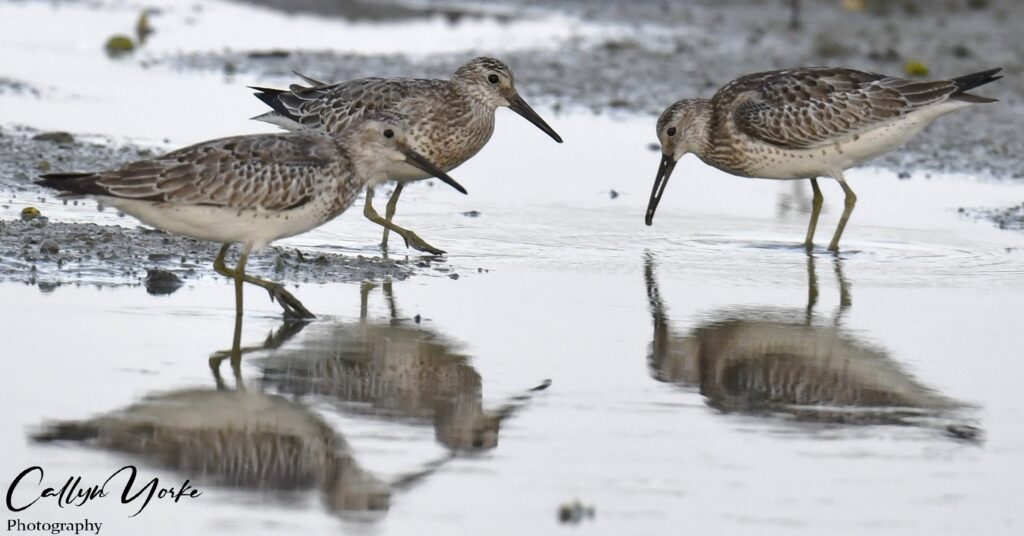
Cam Ranh Bay was the most productive birding location of our Việt Nam coastal survey. In addition to a White-bellied Sea Eagle, seen in flight about 2 km north of the airport, we found fresh tracks of Great Thicknee near the public beach entrance of Bãi Dài. That was a welcomed discovery. The Bãi Dài shoreline and adjacent coastal dune scrub was where I had discovered a population of Great Thicknee in July, 2019. In view of continued habitat loss, it was gratifying to see that these resident shorebirds had managed to survive.
Due to security for the regional airport and military base at Cam Rahn Bay, accessible habitat for finding migratory shorebirds was limited. We spent our time surveying a small number of abandoned aquaculture ponds on private land, on the west-central side of the bay. Those were tidal ponds with fluctuating numbers of shorebirds; ponds furthest from the bay, i.e. westward, being less affected by tides than those immediately adjacent to open water.
The result of differential tidal inundation was that shorebirds in this part of Cam Ranh Bay could be found at one or the other pond sites during high and low tides. Thus, shorebirds had foraging opportunities essentially all day, largely independent of the tides. The fact that we observed the greatest diversity and abundance of shorebirds in this particular coastal location, was probably due to a nearly continuous availability of food in the abandoned aquaculture ponds.
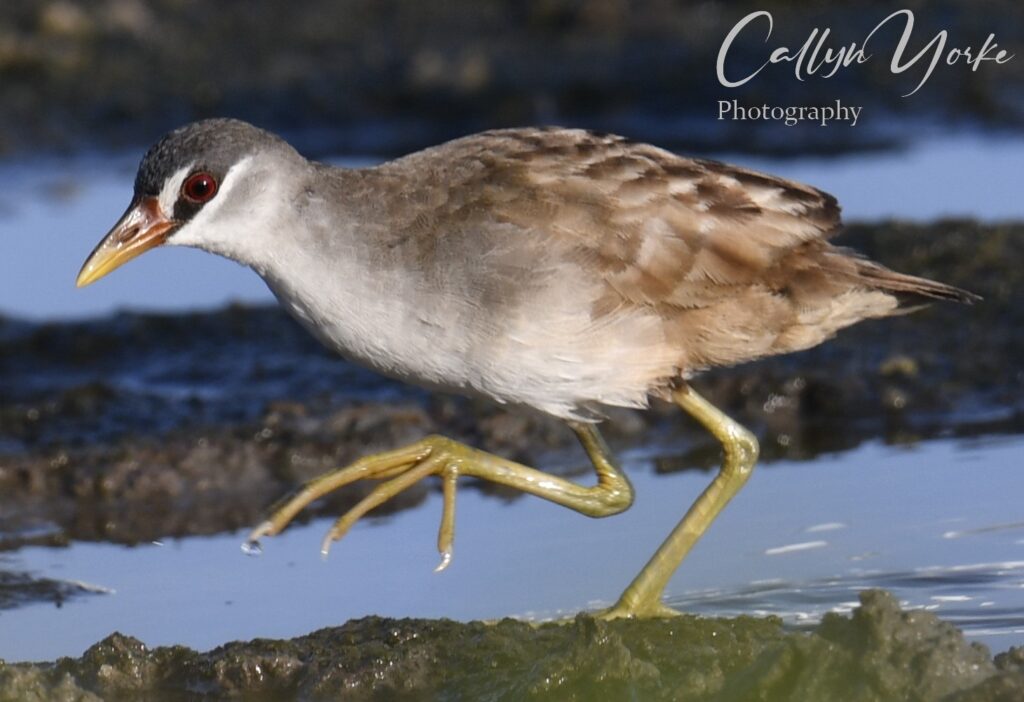
Two afternoon surveys (21 & 22 September- CDY) and two morning surveys (22 & 23 September – CDY) were made at abandoned aquaculture ponds. At least twenty species of waterbird were found, resident and migratory, including several additions to our coastal survey list: White-browed Crake, Pacific Golden Plover, Long-toed Stint and Great Knot. Significantly, Several migratory shorebird species at the ponds occurred in double-digit numbers, e.g. Red-necked Stint (55), Long-toed Stint (18) and Little-ringed Plover (14).

The set of more westerly, less tidal affected ponds, included marginal mangrove (periodically cut), pasture and coastal scrub. Locals netted small fish in the ponds and grazed cattle. Packs of feral dogs ran freely through this area, which also had a heavy accumulation of trash. Flying insects (e.g. Diptera) were abundant. Coastal scrub and mangrove provided suitable food and shelter for herons, plovers, kingfishers, bee-eaters, shrikes and prinias.
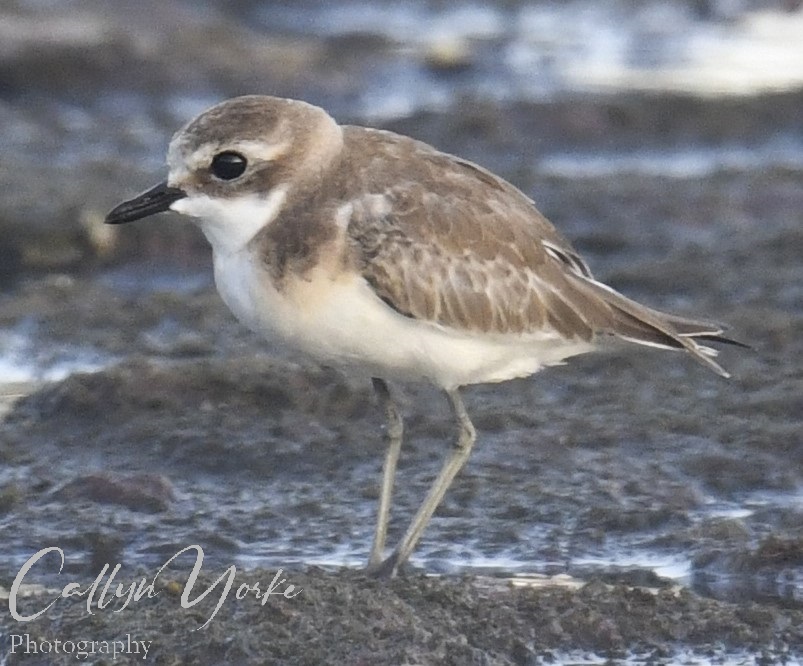
Unfortunately, vegetative cover also provided an opportunity for poaching. We discovered a collapsed 10m x 1m mist net in the mangrove, with five Asian Green Bee-eaters, all of which were skeletonized, evidently having been dead for some time (see photo in Annotated Bird List). The specific purpose of this net was unclear, however its effectiveness for trapping birds flying to and from the mangrove was obviously lethal. The scene was photo-documented and the net removed in an effort to protect resident and migratory birds in the area.

Annotated Bird List, Việt Nam Coastal Bird Survey (September 13-23, 2023) Callyn Yorke and Lê Quý Minh

. ……………………………………………………………………………………………….
Legend
Abundance: Numbers following each species entry are the highest count for a single survey, when multiple surveys at a particular location were made. Locations (see below) with the highest numerical abundance are listed first in the species accounts. When only one of us observed a particular bird species, their initials are given for that account (LQM; CDY).
Age, sex and molt (when known): ad = adult; imm = immature; m = male; f = female; bsc plmg = basic (non-breeding plumage; alt plmg = alternate (breeding) plumage; trans = transitional plumage, i.e. alternate into basic plumage.
Survey Location Abbreviations (see preceeding maps): CBL = Cầu Bù Lu; CD = Cửa Đại; CH= Cửa Hương, Huế; CRB = Cam Ranh Bay; CTU = Cửa Tùng; CV = Cửa Việt; HVP = Hải Vân Pass; LCO = Lăng Cô; ML = Mỹ Lai; MS = Mũi Si; TAI = Thuận An Island, Huế; THI = Tam Hải Island; THO = Tuy Hòa; TX = Thua Xá; TRAN = In transit (with nearest location); Ubiq = Ubiquitous in appropriate habitat.
Ecology and Behavior: aerial insect hawking (ah); taking fruit, berries or parts of flowers (fr); gleaning insects from foliage (ig); probing into surface (pr); estimated height (m) above ground (agl); gregarious (greg); mixed-species flock (msf).
Systematics and Nomenclature used herein, is an amalgam of Avibase, International Ornithological Congress (IOC) and current (2023) online resources, i.e. Birds of the World, Cornell University, USA.
………………………………………………………………………………………
Annotated Bird List
- Chinese Swan Goose Anser cygnoides (domestic wild type) 5, greg. captives in village, TX; CRB.
- Gray-lag Goose Anser anser 2 (exotic, domestic) village gardens, TRAN – Huế.
- Muscovy Duck Cairina moschata (exotic, domestic) 30 (m,f) in farm yard pen, TX.
- Mallard Anas platyrhynchos (exotic, domestic; mostly albinistic) 500,000 (conserv. est), greg., flooded paddy fields and adjacent farm pens; most seen while in transit, ubiq.
- Anas sp. c.f. A. poecilorhynchus 12 greg. a cohesive flock in flight over distant river and paddy fields, apparently migrating, CBL.
- Feral Rock Pigeon Columba livia 60 (exotic) greg. in flocks of 5-10 individuals on pavement and buildings; most common in towns and villages, TRAN -ubiq.
- Red Turtle Dove Streptopelia tranquebarica 8, greg., pairs on utility wires, TRAN – Huế; TX; THI; CRB.
- Eastern Spotted Dove Spilopelia sinensis 6 vocal, greg. pairs; often in villages, ubiq.
- Zebra Dove Geopelia striata 6 vocal, greg., pairs on ground and utility lines, TX; THI; TH; CRB.
- Germain’s Swiftlet Aerodramus germani 100 + greg. semi-domesticated, flying 10-100m agl, lowest when heavily overcast; “nest farming” of this species is a widespread and lucrative business in Vietnam; most coastal towns and villages have artificial nesting sites in buildings, using loud, repetitive playback of the bird’s vocalizations. This increasingly abundant and widespread, semi-domesticated swiftlet is probably displacing other aerial insectivorous species in coastal Vietnam (see following ASPS entry), ubiq.
- Asian Palm Swift Cypsiurus balasiensis 4 loosely greg., flying 10-20m agl; this species and other aerial insectivorous birds (e.g. swifts and swallows), possibly declining and being replaced in the lowlands by the numerically dominant, semi-domesticated GESW, TH; CD.
- Greater Coucal Centropus sinensis 2 often sunning themselves in the morning after rains with wings spread; edge of clearings in tall grass and coastal scrub, ubiq.
- Lesser Coucal Centropus bengalensis 1 noted small size, c.f. GRCO, and faintly streaked mantle; wet plumage from overnight rain, sunning itself in small tree in riverine scrub, TH (photo).

- Green-billed Malkoha Phaenicophaeus tristis 1 in dense coastal scrub on n slope, HVP.
- Plaintive Cuckoo Cacomantis merulinus 1 (m) vocal; TRAN-Huế; CRB (photo).
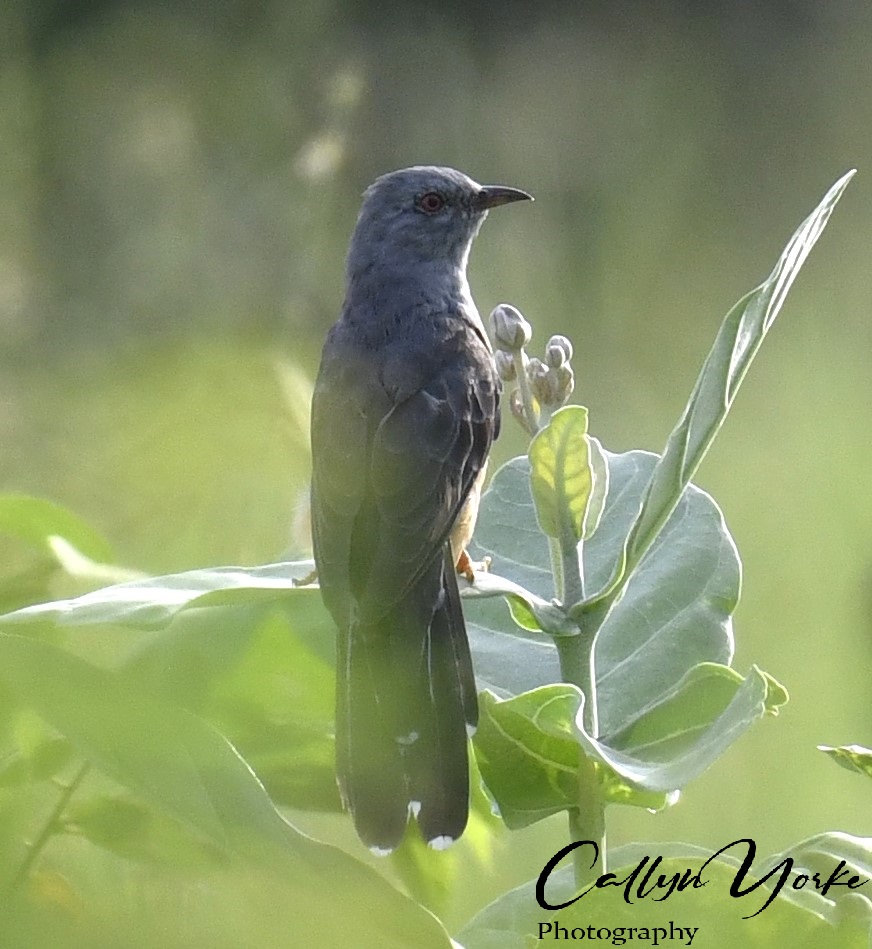
- Slaty-legged Crake Rallina eurizonoides 1 running across roadway, LCO.
- Slaty-breasted Rail Lewina striata 3 (1 ad; 2 imm) greg. running into dense vegetation at edge of inactive aquaculture pond, then across dirt road, TAI (photo – see photo and notes in, Survey Locations – Huế).
- White-browed Crake Amaurornis cinerea 4 greg., pairs active in mangrove and densely vegetated edge of abandoned aquaculture ponds, occasionally coming into the open on mudflats, shy and quickly retreating to cover, CRB (see photo in Survey Locations – CRB).
- Yellow Bittern Ixobrychus sinensis 1 (imm) at edge of a marsh on the shore of a small lagoon, TX.
- Cinnamon Bittern Ixobrychus cinnamomeus 3 individuals, pr in wetlands; often flushed from paddy fields and tall grass, ubiq.
- Black-crowned Night-heron Nycticorax nycticorax 8 individuals flying low over riverine marsh, CBL.
- Striated Heron Butorides striata 3 individuals foraging on mudflats in flooded paddy fields and marshes, ubiq. (photo).
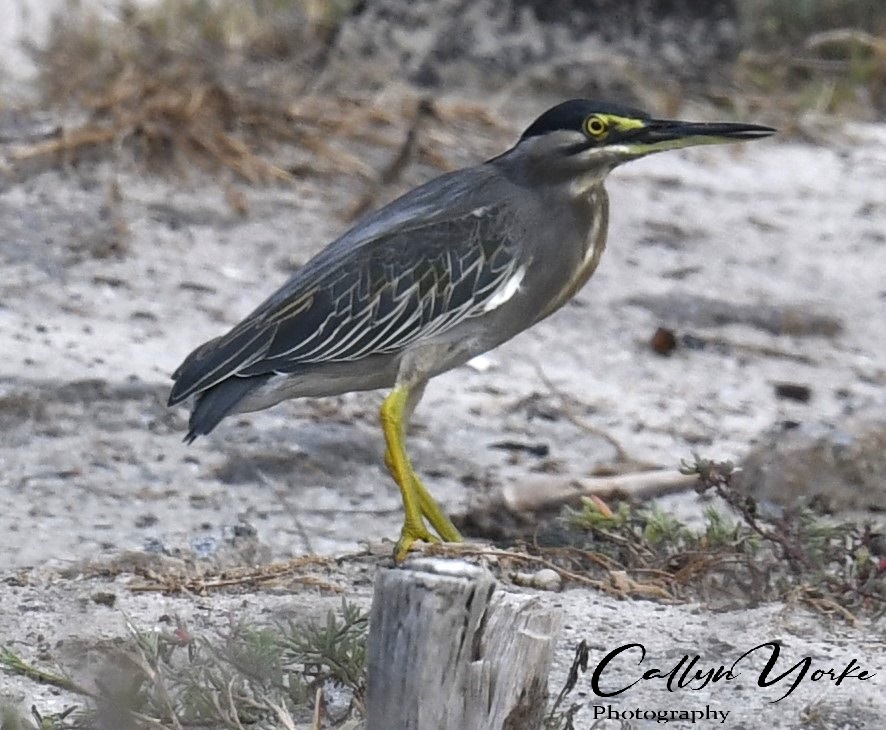
- Chinese Pond Heron Ardeola bacchus 2 individuals flying low over wetlands, TRAN- THI; TX; TRAN-CRB; CRB.
- Eastern Cattle Egret Bubulcus coromandus 60 (about 20% in alt. and trans. plmg.) greg. 5- 20 birds foraging together in low vegetation; also attracted to aquaculture ponds; common in open wetlands, especially paddy fields and pasture with cattle and water buffalo; often in foraging associations with INEG, also in tree roost-heronry (see notes in Survey Location – TX); ubiq.
- Gray Heron Ardea cinerea 12 greg. seen only in flight: a flock flying 30m agl over paddy field, LCO; 5 flying 40m agl w over bay at dawn, TX.
- Intermediate Egret Ardea intermedia 120 (conserv. est.) greg. foraging in flooded paddy fields and low vegetation in other wetlands; attracted to active aquaculture ponds; flights at dusk and dawn, to and from roosts, ubiq (photo – see following entry).
- Little Egret Egretta garzetta 30 attracted in numbers to active and abandoned aquaculture ponds, e.g. CRB; elsewhere, gregarious in single-digit and low double-digit numbers in wetlands, e.g. flooded paddy fields, sometimes loosely associated with numerically dominant ECEG and INEG, ubiq (photo).
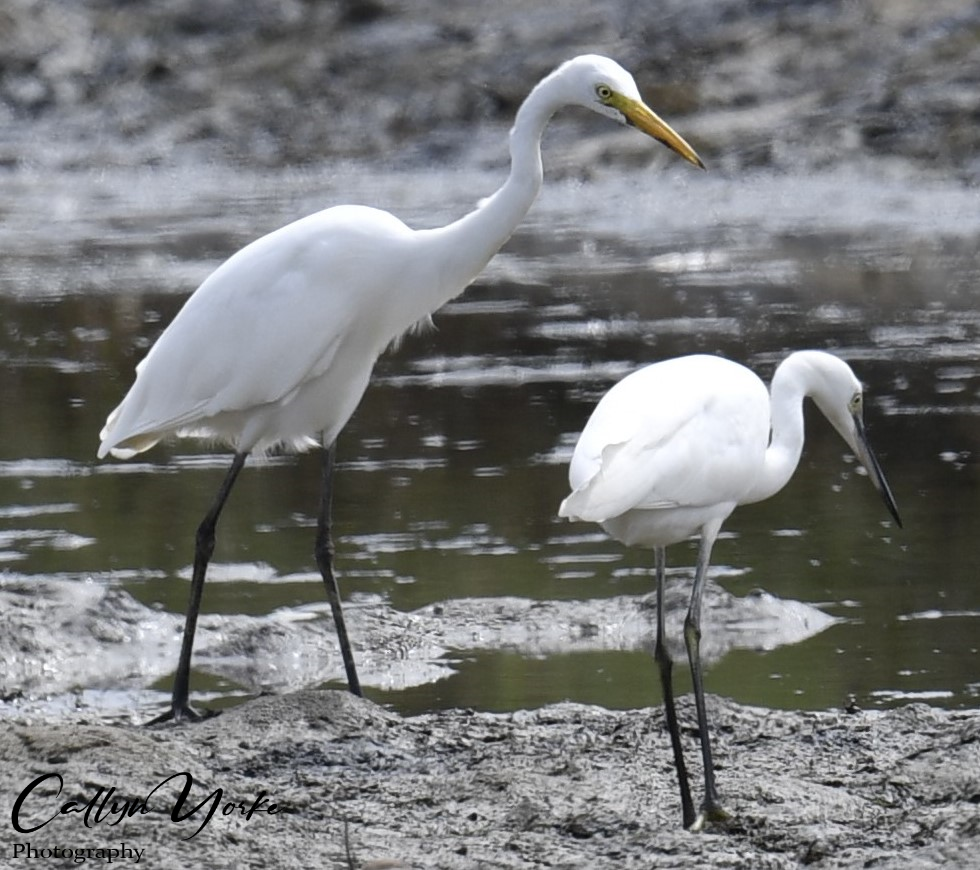
- Great Frigatebird Fregata minor 1 (m, imm.) initially seen soaring 20-80 m agl over a palm-fringed beach about 15 km south of Đà Nẵng; evidently the same immature bird subsequently appeared about 5 km further south over Cửa Đại, circling again at variable heights, above the shore and estuary (see notes and photo in Survey Location – Cửa Đại).
- Great Thicknee Esacus recurvirostris 2 (ad. , imm), initially identified exclusively by its tracks in the beach sand at Cửa Tùng; subsequently two birds were sighted at Thua Xá, and the next morning, tracked and photographed on an isolated peninsular shore (see Survey Locations – 17th Parallel and TX). There, an immature GRTH was seen briefly (this bird was about 3/4 the size of an adult and initially mistaken for a medium-sized plover, e.g. Black-bellied (Gray) Plover). The immature bird was separated from the adult by about 50m, crouching low, partially hidden by debris on the shore. Distant photos were made of it, though mine were unusable. Earlier at this location, adjacent fresh tracks of an immature and adult GRTH were found in the sand, indicating that both birds had been covering the same ground, together or separately. After running a short distance and watching us for a few minutes, first the adult, then the immature, flushed and flew low over the lagoon in a westward direction and soon out of view.
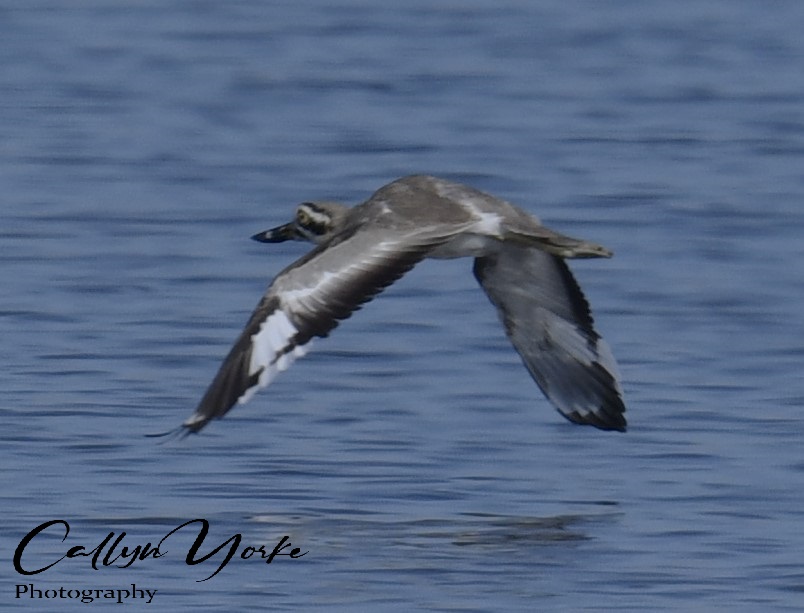
The following day (September 21, 2023) adjacent to the public beach entrance of Bãi Dài, Cam Ranh Bay, we found a set of fresh GRTH tracks in the sand; the owner of those tracks was not seen, however. Because GRTH is variably crepuscular and nocturnal, it may frequently be overlooked, even by experienced observers. For that reason, and judging by tracks that are readily identifiable on shorelines and adjacent dunes, its current status as ‘rare‘ in Việt Nam should probably be changed to ‘locally fairly common.’ Remarkably, this interesting, monotypic bird has adapted and survived in coastal areas with significant habitat loss and frequent anthropogenic disturbances.
- Black-winged Stilt Himantopus himantopus 8 greg. pairs and small, loosely greg. flocks foraging in flooded fields; shallow freshwater and tidal ponds, TRAN-CRB; CRB; LCO.
- Black-bellied (Gray) Plover Pluvialis squatarola 1 (bsc. plmg.) on mudflat of interior lagoon, CD.
- Pacific Golden Plover Pluvialis fulva 1 (trans. plmg.) on sandflats of abandoned aquaculture pond, remaining partly concealed in salt grass and pickleweed, CRB.
- Little Ringed Plover Charadrius dubius 14 (ad., imm; alt. & bsc. plmg.) loosely gregarious on mud and sand substrates of abandoned aquaculture ponds; also mangrove and muddy edges of drainages, CRB (photo); CD; LCO; THI; TX.
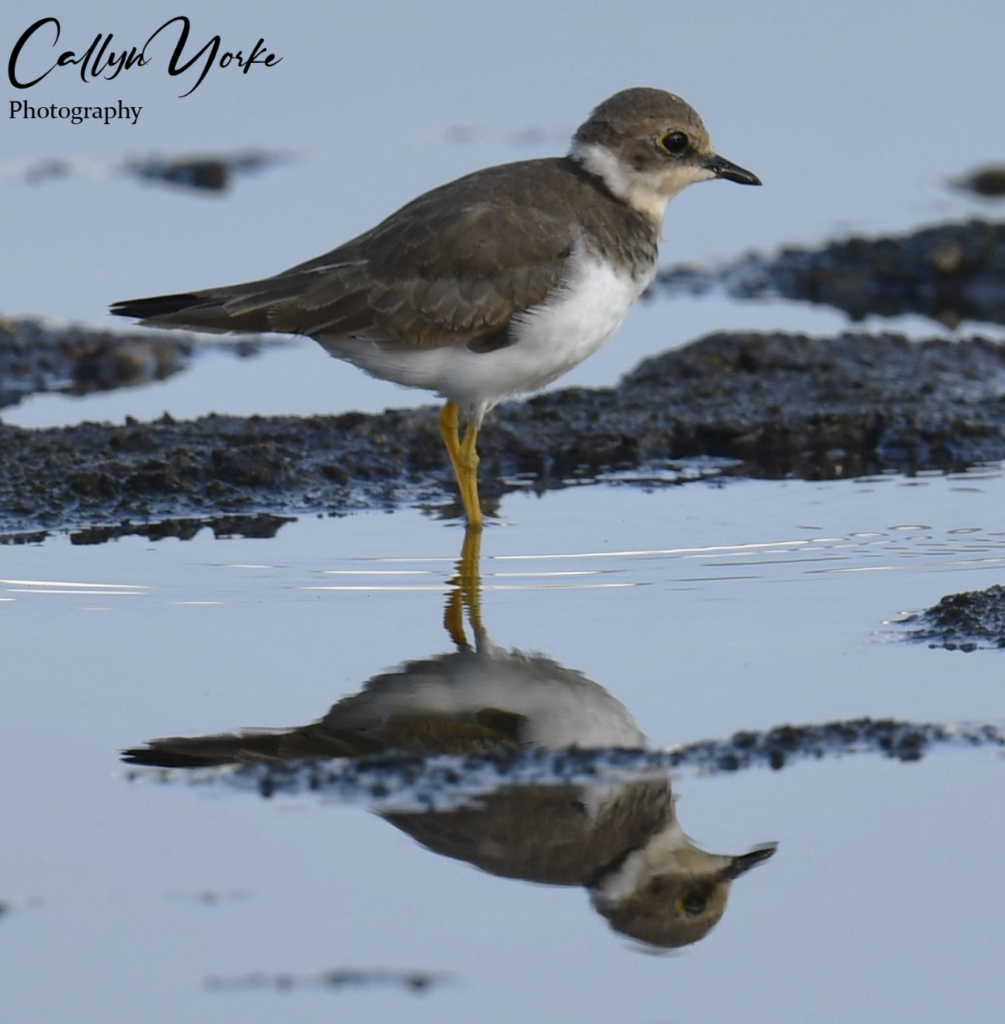
- White-faced Plover Charadrius dealbatus 5 individuals and pairs on outer beaches and interior mudflats, abandoned aquaculture ponds, ubiq. (photo).
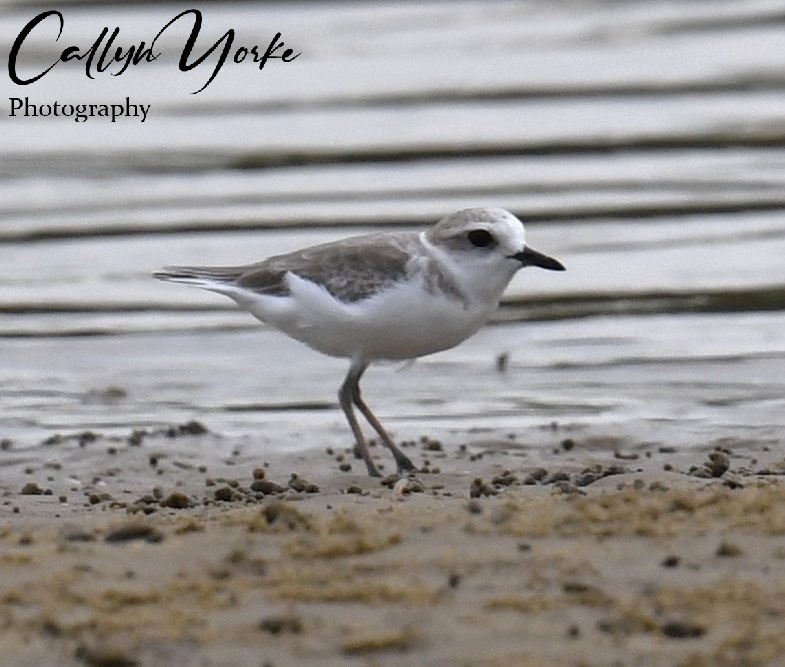
- Lesser Sandplover Charadrius atrifrons 5 loosely gregarious in msf, though never numerically dominant to other shorebirds, e.g. GRSP, RNST, LTST on mudflats, lagoon shores, abandoned aquaculture ponds, ubiq. (see photo in Survey Locations – CRB).
- Greater Sandplover Charadrius leschenaultii 8 (bsc. and trans. plmg.) CRB – loosely gregarious, usually in msf with other shorebirds; mudflats, sandy shores, abandoned aquaculture ponds, ubiq. (photo)
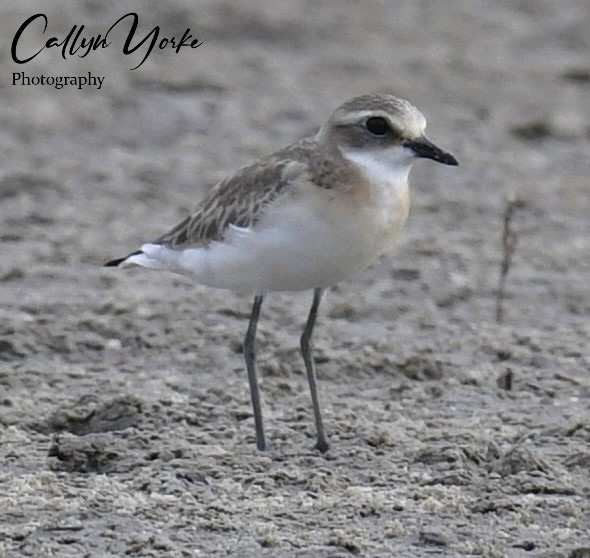
- Black-necked Lapwing Vanellus atronuchalis 6 loosely greg. in pasture ponds and flooded fields, LCO; CBL; TRAN- Huế; TRAN – THI.
- Greater Painted Snipe Rostratula benghalensis 1 flushed from drainage in coastal dunes with Casuarina woodland, TRANS-Cửa Việt.
- Eurasian Whimbrel Numenius phaeopus 8 greg. (ad., imm.) pairs and small flocks on outer shores, THI; individuals and pairs frequenting bayside and large lagoon mudflats and open water shorelines, ubiq.
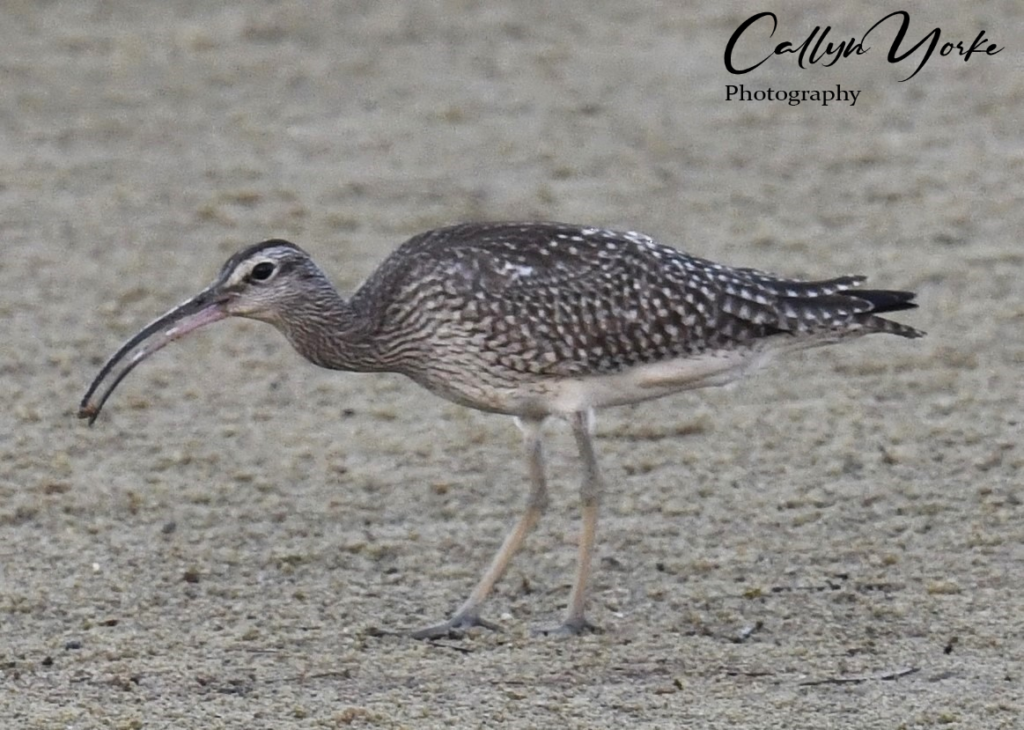
- Eastern Black-tailed Godwit Limosa malanuroides 1 (trans. plmg.) on riverbank mudflat, TX.
- Ruddy Turnstone Arenaria interpres 7 greg. (trans. plmg.) on mudflats and shore of estuaries and lagoons; two caught in segmented funnel fish trap, (see notes and photo, Survey Locations – CD); TX.
- Great Knot Calidris tenuirostris 5 (bsc. plmg.) greg. a small flock walking and pr. in msf of other shorebird species, e.g. GRSP, RNST, on mudflat of eastern-most abandoned aquaculture pond at low tide; seen only once in three separate surveys of the ponds; not found at any other site we surveyed and my first record of this species at CRB (see photo in Survey Location – CRB).
- Broad-billed Sandpiper Calidris falcinellus 4 (bsc. plmg.) greg. 4 foraging with other shorebirds on mudflat of abandoned aquaculture pond at low tide, CH; CRB; CD (photo).

- Long-toed Stint Calidris subminuta 18 (bsc. plmg.) loosely greg., pr. in shallows of abandoned ponds with other shorebirds, e.g. RNST, MASA and WOSA, CRB; this species not found at any other sites we surveyed (see photo in Survey Locations – CRB).
- Red-necked Stint Calidris ruficollis 55 (bsc. and trns. plmg.) greg. pairs pr. deeply into substrate very actively on mudflats of abandoned ponds, CRB; CH.
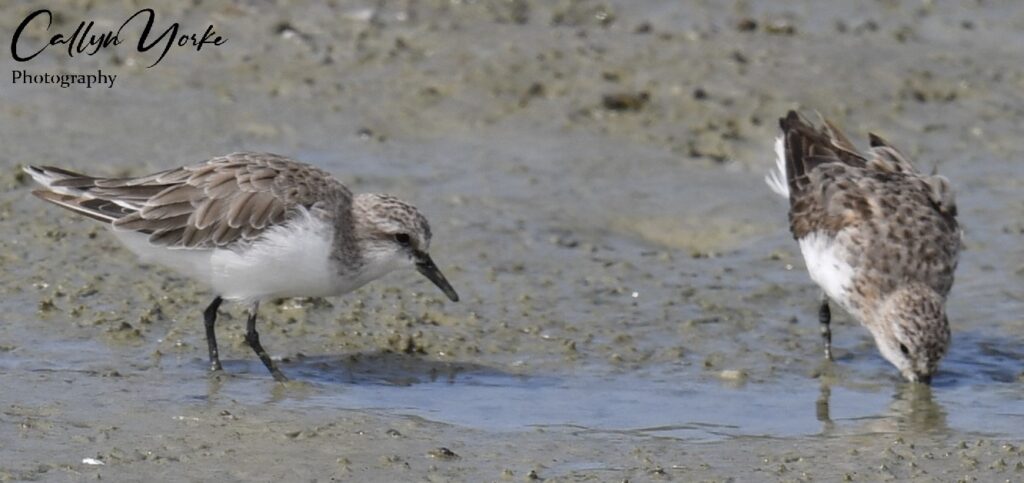
- Sanderling Calidris alba 4 (trans. plmg.) greg. running and pr on mudflat and sandy shallows of lagoon, CD; THI (see photo in Introduction).
- Common Snipe Gallinago gallinago 1 flushed from inner lagoon, CD (LQM).
- Terek Sandpiper Xenus cinereus 8 loosely greg. running and pr. on mudflats, lagoon shore, and abandoned ponds, XA; CH; THI; CRB (photo).

- Common Sandpiper Actitis hypoleucos 10 loosely greg. individuals and pairs in msf with other shorebirds on shorelines, mudflats, and wetlands, ubiq.
- Common Greenshank Tringa nebularia 6 (bsc. plmg.) loosely greg. individuals and pairs on abandoned aquaculture ponds, lagoon mudflats, CH; CBL; TRAN – Huế; TX; CD.
- Common Redshank Tringa totanus 1 on lagoon mudflat, CD;THI.
- Wood Sandpiper Tringa glareola 6 greg. pairs in shallows of abandoned aquaculture ponds, CRB; on mudflat, THI.
- Marsh Sandpiper Tringa stagnatilis 4 greg. pairs in shallows of aquaculture ponds, CD; CH (see photo in Survey Locations – CRB).
- Yellow-legged Buttonquail Turnix tanki 6 greg. crossing roadway into tall grass, LCO.
- Little Tern Sternula albifrons 16 greg. circling lagoon and dip-diving offshore, CD.
- Whiskered Tern Chlidonias hybrida 4 – 10 greg. circling, flying low over a variety of wetlands, rivers and lagoons; alighting on isolated sandbars, ubiq (photo).
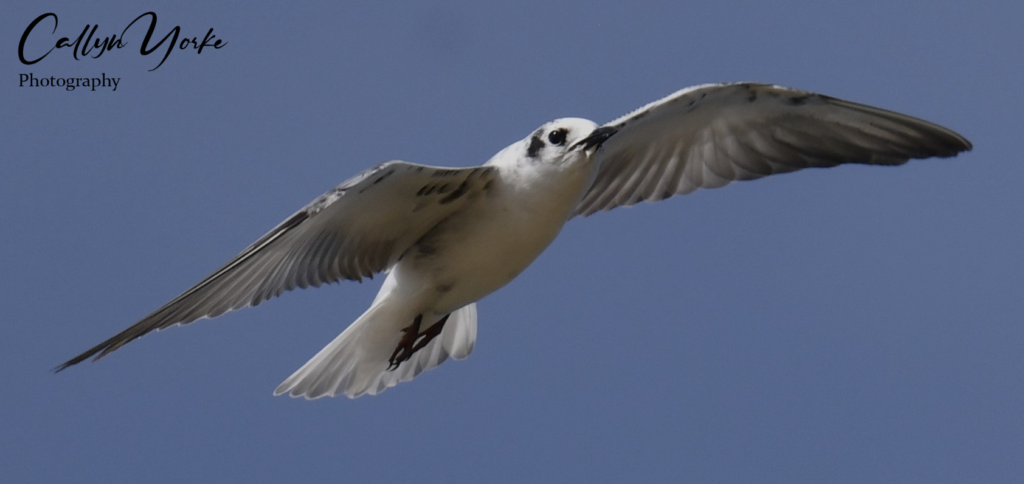
- Lesser Crested Tern Thalasseus bengalensis 1 resting on a distant sandbar in lagoon, TX.
- Greater Crested Tern Thalasseus bergii 2 greg. pairs flying 2-20m agl over estuary and lagoon, also offshore, ubiq.
- Eastern Barn Owl Tyto javanica 1 vocal, flying over lagoon at dusk, TX, (LQM).
- White-bellied Sea-eagle Haliaeetus leucogaster 1 (imm – c.f. 2nd yr.) flying 30m agl over coastal roadway about 2 km north of Cam Ranh airport, CRB.
- Eurasian Hoopoe Upupa epops 1 in flight over coastal roadway bordered by casuarinas, TRAN- TX-THO, (LQM).
- Asian Green Bee-eater Merops orientalis 4 greg. often sallying to or near the ground from 1m agl perch; CRB (photos); five individuals of this species were found dead and skeletonized in a CRB mist net,CD; THI; TX; CRB.
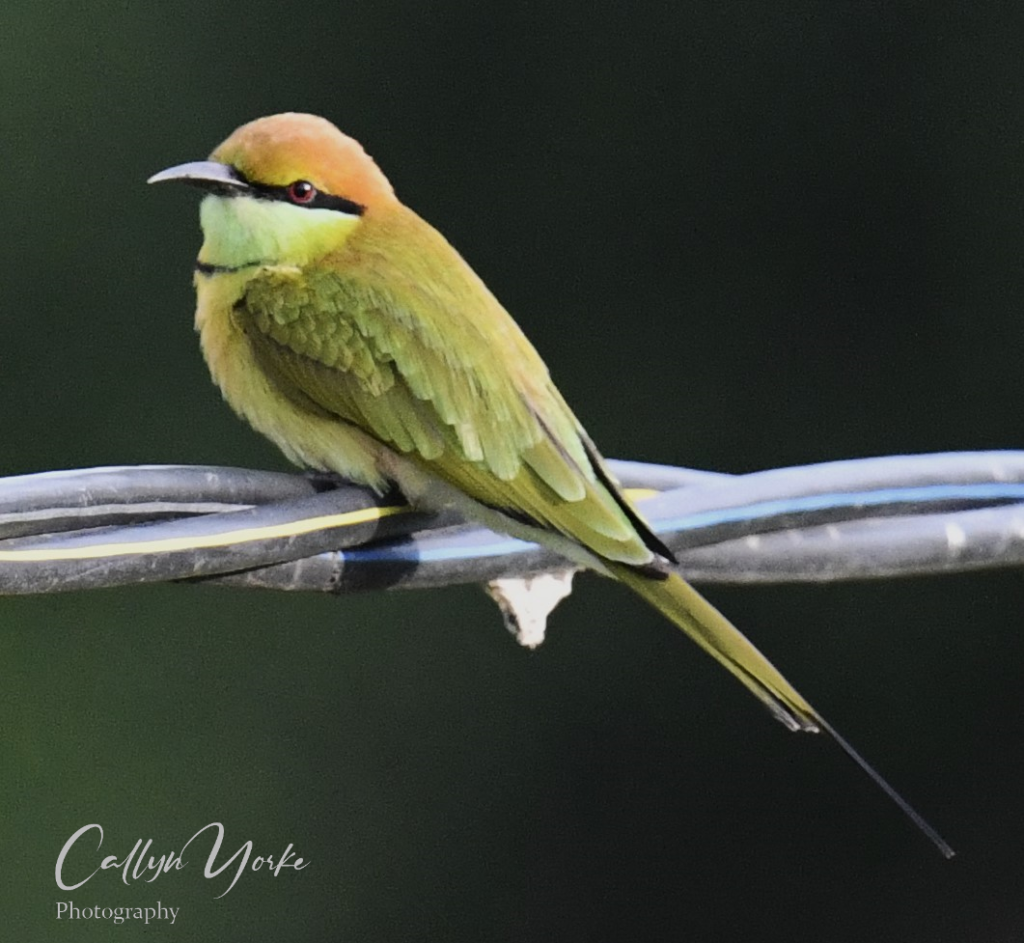
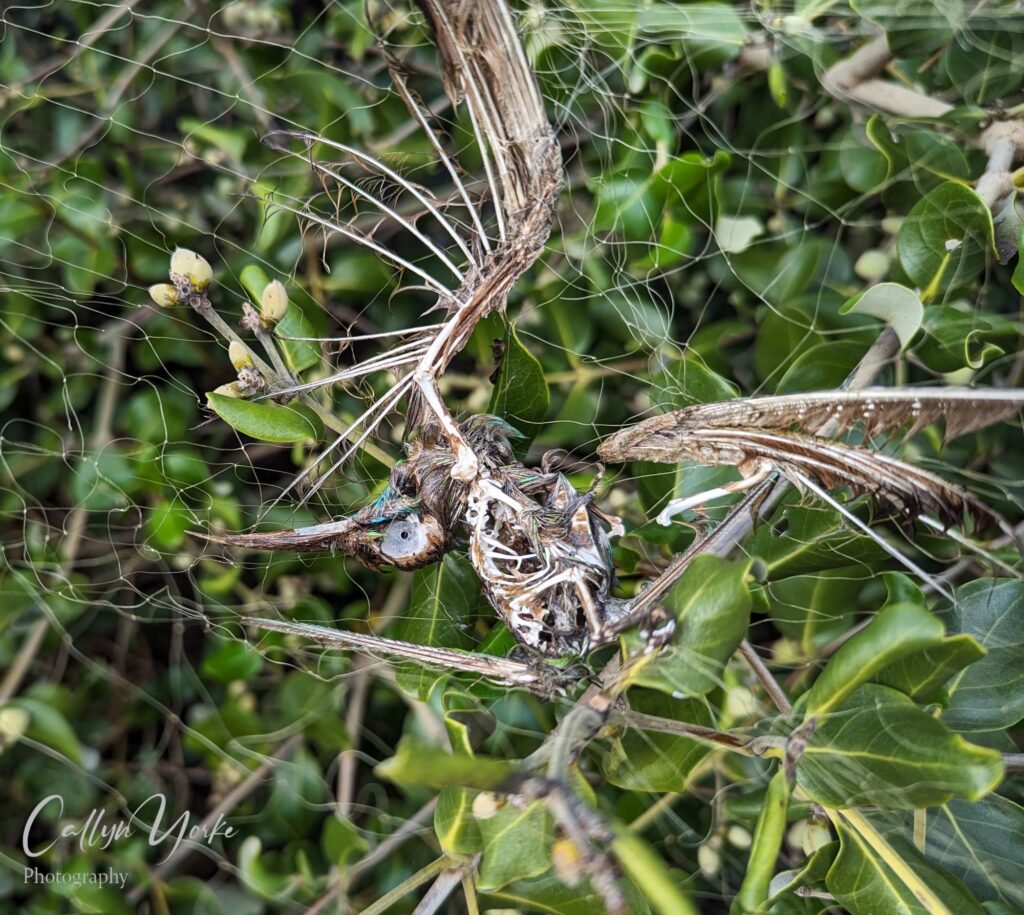
- Blue-throated Bee-eater Merops viridis 2 in sallying from Casuarinas at edge of lagoon, CD.
- Blue-tailed Bee-eater Merops philippinus 16 greg. in beach scrub, paddy fields, on utility lines and in isolated trees, ah, LCO; CBL; CH; TRAN – Huế;; THI; TX.
- Common Kingfisher Alcedo atthis 5 individuals perched at active aquaculture ponds, tidal lagoons and paddy fields, ubiq (photo).
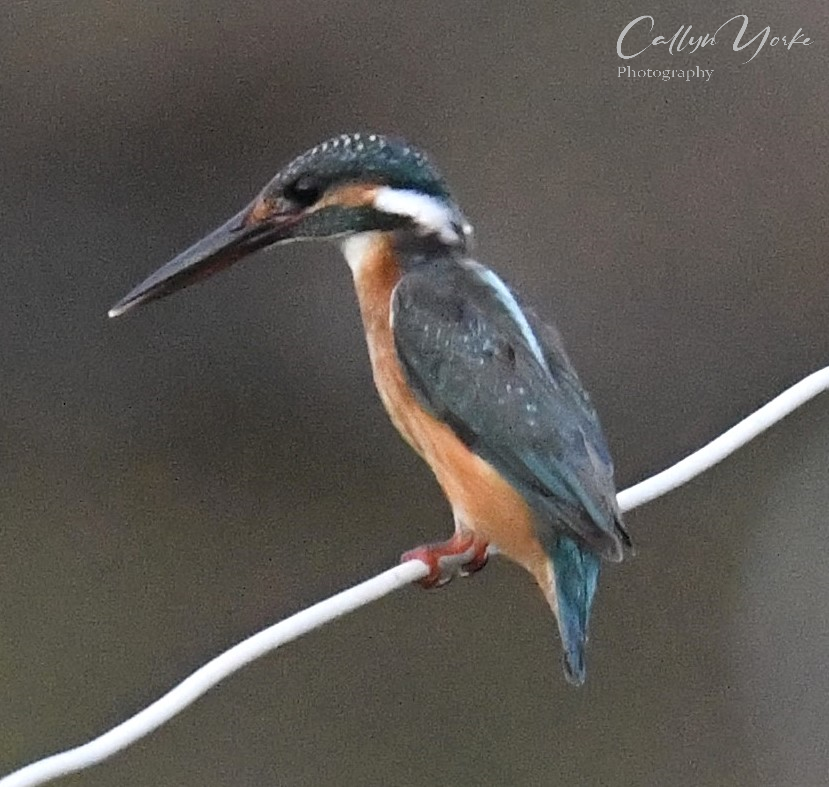
- Pied Kingfisher Ceryle rudis 1 hovering over river channel, THI.
- Stork-billed Kingfisher Pelargopsis capensis 1 flushed from casuarina-sand dune area with stagnant ponds and drainages, TRAN- Huế – Quảng Trị.
- White-breasted Kingfisher Halcyon smyrnensis 2 individuals at edges of lagoons, shrub-bordered ponds, ubiq.
- Collared Kingfisher Todiramphus chloris 1 flew low across lagoon into mangrove, CBL.
- Necklaced Barbet Psilopogon auricularis 1 vocal, north slope roadside second-growth, HVL (LQM).
- Gray-headed Parakeet Psittacula finschii 2 foraging in Eucalyptus, adjacent property ML.
- Common Iora Aegithina tiphia 1 in roadside trees and second-growth, CBL.
- Sunda Pied Fantail Rhipidura javanica 1 riverside walkway hedgerow, THO (LQM).
- Black Drongo Dicrurus macrocercus 12 individuals and pairs mid-level in Eucalyptus and Acacia trees at edge of clearings, paddy fields and coastal scrub, LCO; CBL; TRAN – Huế; THI; TX;
- Greater Racquet-tailed Drongo Dicrurus paradiseus 1 in patchy woodland and second-growth at edge of lagoon, CBL (LQM).
- Northern Brown Shrike Lanius cristatus 2 individuals perched 1-2m agl coastal scrub and second-growth; edge of paddy fields, TRAN- Huế; TX; TRAN – THO; THO; CRB (photo).
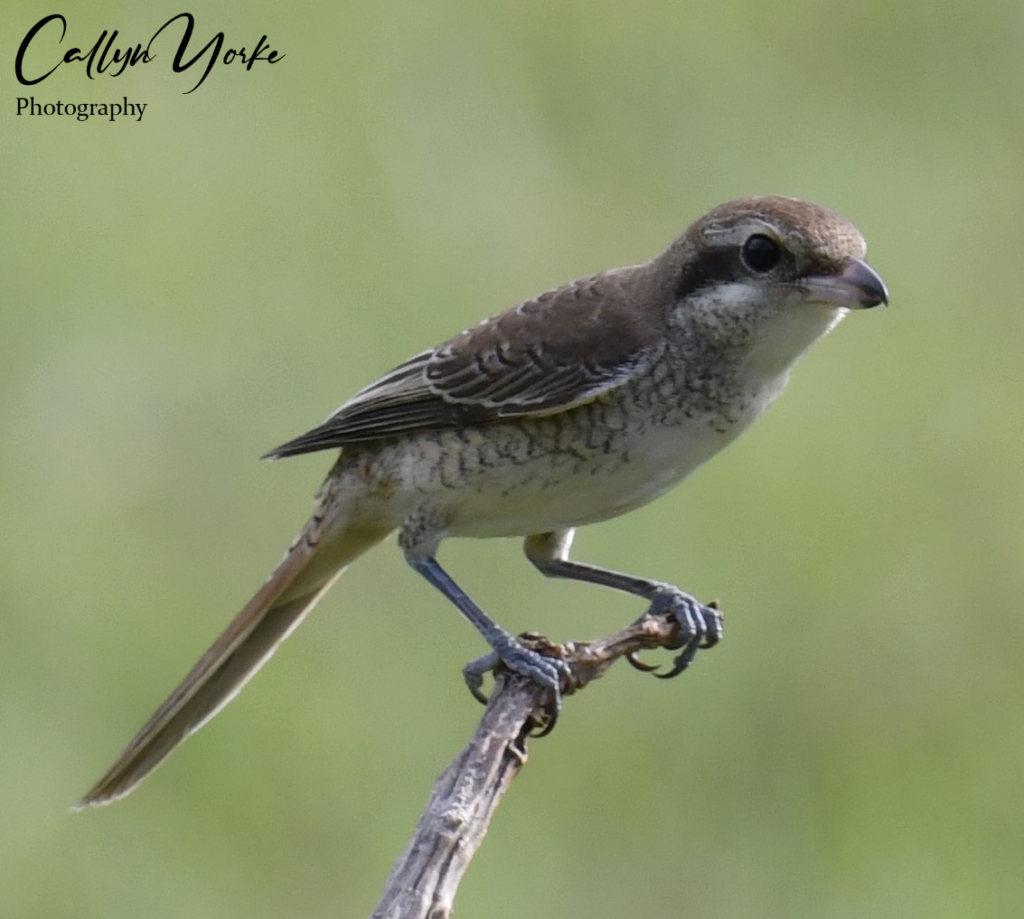
- Long-tailed Shrike Lanius schach 12 most observed while in transit; individuals in open fields and edge of second-growth; gardens and paddy fields, often seen on utility wires, ubiq.
- Racquet-tailed Treepie Crypsirina temia 1 in dense second-growth on north slope, HVP.
- Eastern Jungle-Crow Corvus levaillantii 1 flying w at about 30m agl, THI.
- Cinereous Tit Parus cinereus 4 greg. in mangrove, THI.
- Japanese Tit Parus minor 4 in Casuarina woodland, TRAN- Huế – Cửa Tùng; MS; TRAN ML-THI (LQM).
- Double Zitting Cisticola Cisticola tinnabulans 3 in tall grass at edge of paddy fields, CBL; TX;
- Rufescent Prinia Prinia rufescens 1 vocal, TRAN – MS (LQM).
- Yellow-bellied Prinia Prinia flaviventris 3 vocal, active in tall grass and shrubs adjacent to ponds and flooded fields, LCO; CBL; TX.
- Plain Prinia Prinia inornata 5 vocal, greg. , active, usually staying low and hidden in tall, wet grass, coastal scrub near water, CRB; THO; CH; THI; TX;
- Common Tailorbird Orthotomus sutorius 4 vocal (usually unseen) in second-growth, dense coastal scrub, ubiq.
- Lanceolated Warbler Locustella lanceolata 2 active in tall grass at edge of paddy field, TX.
- Oriental Reed Warbler Acrocephalus orientalis 1 vocal, active and perched conspicuously atop tall grass and herbs in marshy edge of paddy field, TX (photo).
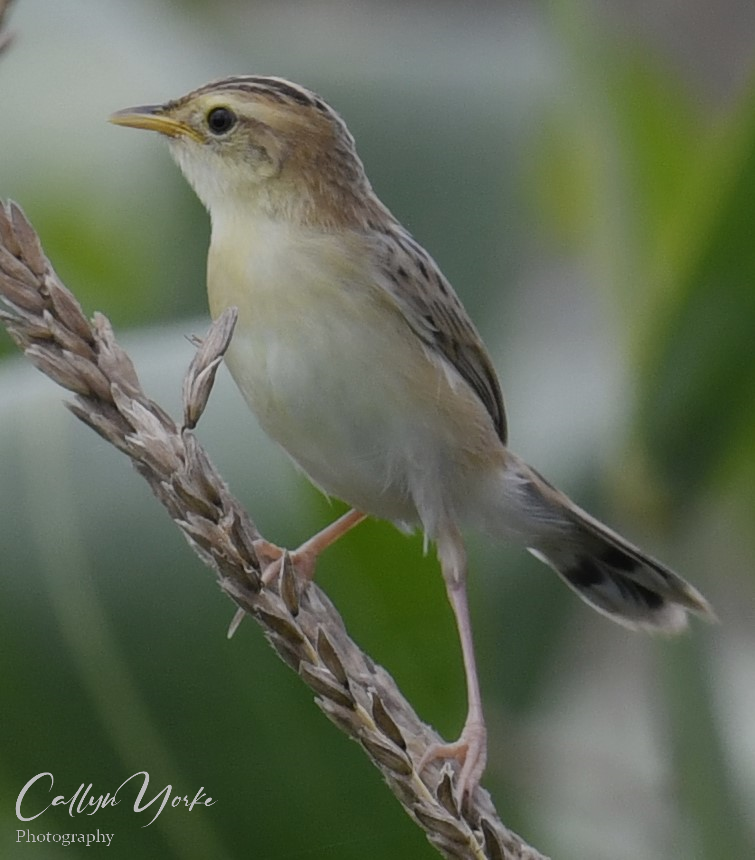
- Eurasian Barn Swallow Hirundo rustica 5 individuals and pairs in flight, 5 – 15 m agl, TRAN- Huế – Cửa Tùng; TX; HVP; CRB.
- Light-vented Bulbul Pycnonotus sinensis 5 vocal, greg. in Eucalyptus and mangrove trees, THI.
- Northern Sooty-headed Bulbul Pycnonotus chrysorrhoides 20 vocal, active in trees at edge of dense second-growth,; LCO, CBL; HVP.
- Southern Sooty-headed Bulbul Pycnonotus aurigaster vocal, roadside second-growth, south slope of HVP.
- Stripe-throated Bulbul Pycnonotus finlaysoni 3 vocal, greg. active, though rather secretive in dense second-growth, ubiq.
- Streak-eared Bulbul Pycnonotus conradi 12 vocal, greg., active in gardens, parks, twons and second-growth; often sympatric with the less numerous STBU; ubiq.
- Oriental White-eye Zosterops palpebrosus 5 greg. active in canopy of mangrove, THI (photo).
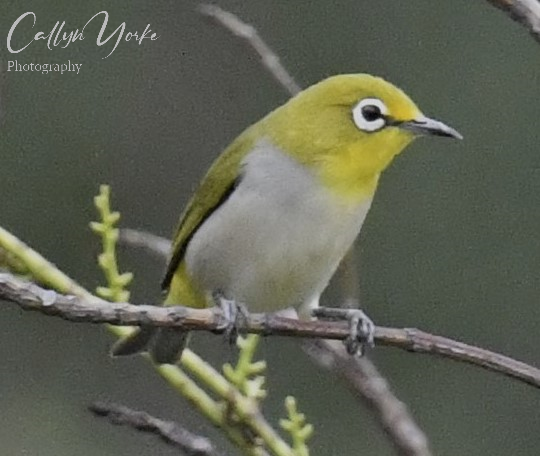
- Pin-striped Tit-babbler Mixornis gularis 1 vocal dense second-growth on north slope of HVP.
- Buff-breasted Babbler Trichastoma tickelli 1 vocal, dense second-growth on north slope of HVP, (LQM).
- Abbott’s Babbler Malacocincla abbotti 1 vocal, dense second-growth on north slope of HVP, (LQM).
- Masked Laughingthrush Garrulax perspicillatus 8 vocal, greg. active, though secretive in garden trees and tall second-growth, ubiq. (from Cửa Đại northward).
- Black-collared Starling Gracupica nigricollis 2 on edge of pond and pasture next to tall second-growth, TRAN- HV -Huế.
- White-shouldered Starling Sturnia sinensis 16 greg. most often seen in flight over wetlands, ubiq.
- Common Myna Acridotheres tristis 10 vocal, greg. pairs on ground and pavement, villages and towns, ubiq.
- Vinous-breasted Myna Acridotheres leucocephalus 6 greg. on utility poles and in trees at edge of paddy fields, LCO.
- Oriental Magpie Robin Copsychus saularis 1 in clearing of dense second-growth on north slope of HVP; bathing with EUTS in roadside garden, CRB.
- Asian Brown Flycatcher Muscicapa dauurica 1 second-growth on cliffside facing the sea, MS (photo); THI.
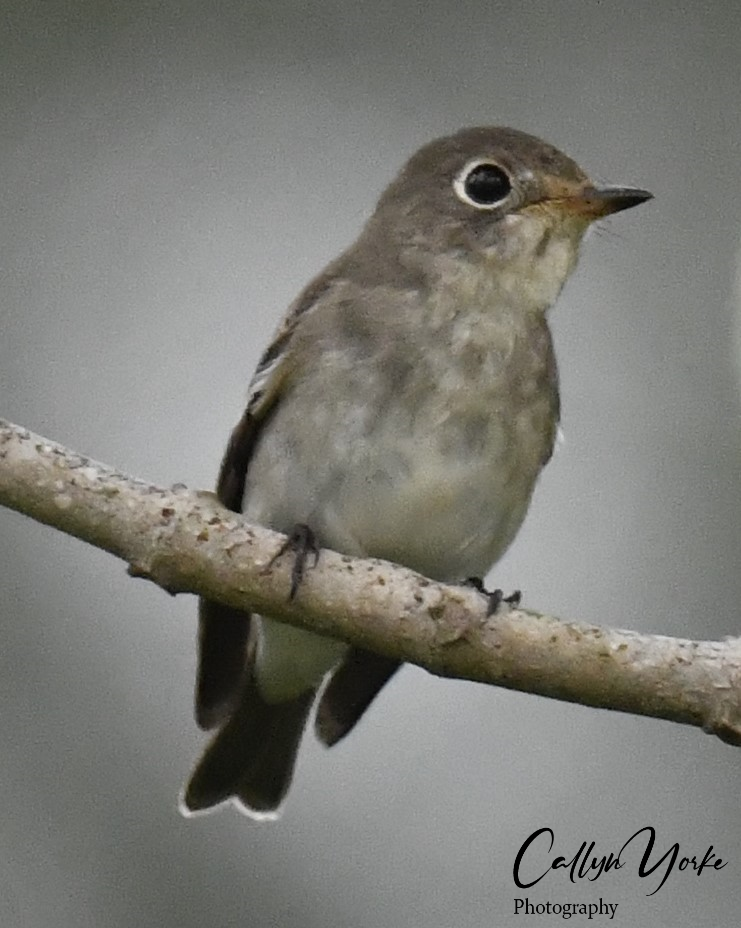
- Rufous-tailed Robin Larvivora sibilans 1 vocal (unseen) in dense, roadside second-growth on north slope of HVP (LQM).
- Ornate Sunbird Cinnyris ornatus 2 (m,f) individuals and pairs active in mangrove and coconut palms; gardens, THI; TX.
- Scaly-breasted Munia Lonchura punctulata 6 greg. in tall grass and low second-growth bordering paddy fields wetlands, LCO; CBL; THO.
- Indian (House) Sparrow Passer indicus 2 (m,f), often sympatric yet never as abundant as the numerically dominant EUTS; village garden outside of Huế; village streets of THI; CRB.
- Plain-backed Sparrow Passer flaveolus 3 (m,f) in tall, coastal scrub at edge of paddy fields and villages, TX; CRB.
- Eurasian Tree Sparrow Passer montanus 30 (m,f) vocal, greg. on ground and buildings, in trees, towns and villages, ubiq.
- Paddyfield Pipit Anthus rufulus 10 loosely greg. in an assortment of wetlands, including shorelines, abandoned aquaculture ponds, pastureland, ubiq (photo).
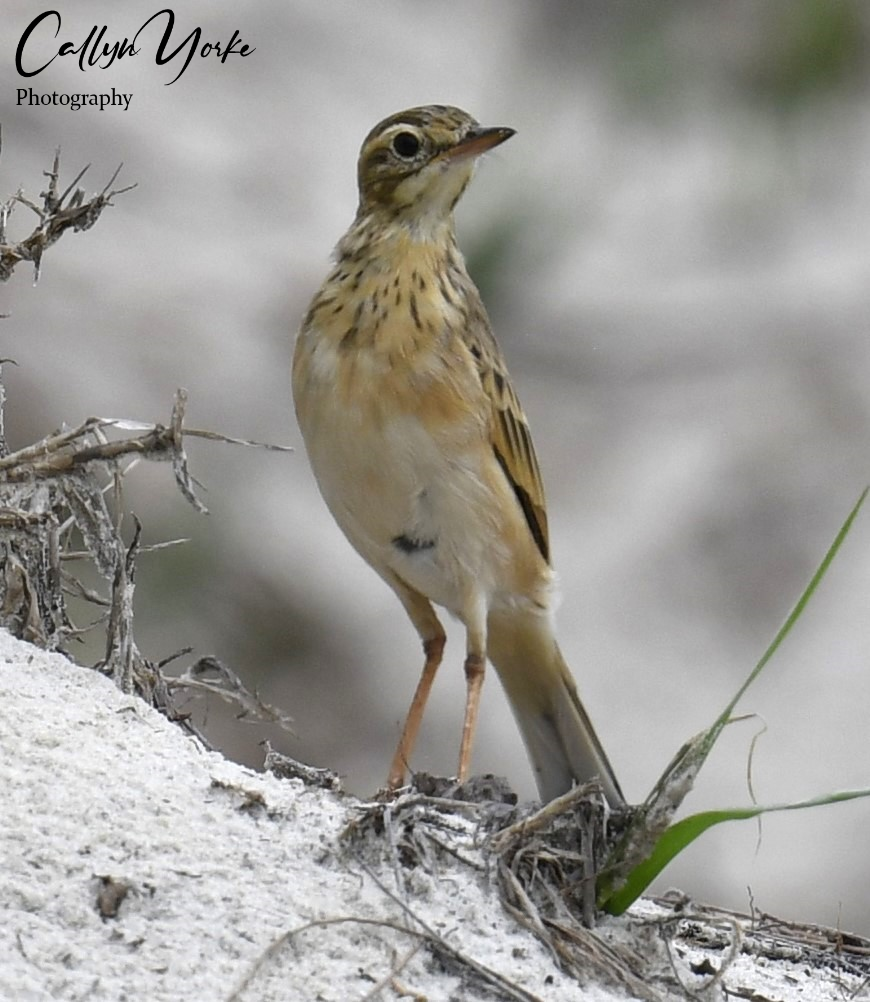
- Gray Wagtail Motacilla cinerea 5 on ground in a variety of open areas, usually near water, ubiq.
- Eastern Yellow Wagtail Motacilla tschutschensis 1 (imm) on wet pasture with GRWA and PAPI, at edge of abandoned aquaculture ponds, CRB.
- Chinese Wagtail Motacilla leucopsis 1 in flight, HVP.
__________________________________________________________________________